
Written by Vasilena Markova • September 27, 2023 • 12:58 pm • Internet

Round-Trip Time (RTT): What It Is and Why It Matters
Round-Trip Time (RTT) is a fundamental metric in the context of network performance, measuring the time it takes for data packets to complete a round trip from source to destination and back. Often expressed in milliseconds (ms), RTT serves as a critical indicator for evaluating the efficiency and reliability of network connections. In today’s article, we dive into the concept of RTT, exploring how it works, why it matters in our digital lives, the factors that influence it, and strategies to enhance it. Whether you’re a casual internet user seeking a smoother online experience or a network administrator aiming to optimize your digital infrastructure, understanding this metric is critical in today’s interconnected world.
Table of Contents
What is Round-Trip Time (RTT)?
Round-Trip Time is a network performance metric representing the time it takes for a data packet to travel from the source to the destination and back to the source. It is often measured in milliseconds (ms) and is a crucial parameter for determining the quality and efficiency of network connections.
To understand the concept of RTT, imagine sending a letter to a friend through the postal service. The time it takes for the letter to reach your friend and for your friend to send a reply back to you forms the Round-Trip Time for your communication. Similarly, in computer networks, data packets are like those letters, and RTT represents the time it takes for them to complete a round trip.
How Does it Work?
The concept of RTT can be best understood by considering the journey of data packets across a network. When you request information from a web server, for example, your device sends out a data packet holding your request. This packet travels through various network devices in between, such as routers and switches, before reaching the destination server. Once the server processes your request and prepares a response, it sends a data packet back to your device.
Round-Trip Time is determined by the time it takes for this data packet to travel from your device to the server (the outbound trip) and then back from the server to your device (the inbound trip). The total RTT is the sum of these two one-way trips.
Let’s break down the journey of a data packet into several steps so you can better understand the RTT:
- Sending the Packet: You initiate an action on your device that requires data transmission. For example, this could be sending an email, loading a webpage, or making a video call.
- Packet Travel: The data packet travels from your device to a server, typically passing through multiple network nodes and routers along the way. These middle points play a significant role in determining the RTT.
- Processing Time: The server receives the packet, processes the request, and sends a response back to your device. This processing time at both ends also contributes to the Round-Trip Time.
- Return Journey: The response packet makes its way back to your device through the same network infrastructure, facing potential delays on the route.
- Calculation: It is calculated by adding up the time taken for the packet to travel from your device to the server (the outbound trip) and the time it takes for the response to return (the inbound trip).
Why does it matter?
At first look, Round-Trip Time (RTT) might seem like technical terminology, but its importance extends to various aspects of our digital lives. It matters for many reasons, which include the following:
- User Experience
For everyday internet users, RTT influences the sensed speed and responsiveness of online activities. Low Round-Trip Time values lead to a seamless experience, while high RTT can result in frustrating delays and lag during tasks like video streaming, online gaming, or live chats.
- Network Efficiency
Network administrators and service providers closely monitor RTT to assess network performance and troubleshoot issues. By identifying bottlenecks and areas with high RTT, they can optimize their infrastructure for better efficiency.
- Real-Time Applications
Applications that rely on real-time data transmission, such as VoIP calls, video conferencing, and online gaming, are highly sensitive to RTT. Low RTT is crucial for smooth, interruption-free interactions.
In cybersecurity, Round-Trip Time plays a role in detecting network anomalies and potential threats. Unusually high RTT values can be a sign of malicious activity or network congestion.
Factors Affecting Round-Trip Time (RTT)
Several factors can influence the metric, both positively and negatively. Therefore, understanding these factors is crucial, and it could be very beneficial for optimizing network performance:
- Distance: The physical distance between the source and destination plays a significant role. Longer distances result in higher RTT due to the time it takes for data to travel the network.
- Network Congestion: When a network experiences high volumes of traffic or congestion, data packets may be delayed as they wait for their turn to be processed. As a result, it can lead to packet delays and increased RTT.
- Routing: The path a packet takes through the network can significantly affect RTT. Efficient routing algorithms can reduce the time, while not-so-optimal routing choices can increase it.
- Packet Loss: Packet loss during transmission can occur due to various reasons, such as network errors or congestion. When lost, packets need to be retransmitted, which can seriously affect the Round-Trip Time.
- Transmission Medium: It is a critical factor influencing RTT, and its characteristics can vary widely based on the specific medium being used. Fiber optic cables generally offer low RTT due to the speed of light in the medium and low signal loss. In contrast, wireless mediums can introduce variable delays depending on environmental factors and network conditions.
How to improve it?
Improving Round-Trip Time (RTT) is a critical goal for network administrators and service providers looking to enhance user experiences and optimize their digital operations. While some factors affecting it are beyond our control, there are strategies and practices to optimize Round-Trip Time for a smoother online experience:
- Optimize Routing: Network administrators can optimize routing to reduce the number of hops data packets take to reach their destination. This can be achieved through efficient routing protocols and load balancing .
- Optimize Network Infrastructure: For businesses, investing in efficient network infrastructure, including high-performance routers and switches, can reduce internal network delays and improve RTT.
- Upgrade Hardware and Software: Keeping networking equipment and software up-to-date ensures that you benefit from the latest technologies and optimizations that can decrease RTT.
- Implement Caching: Caching frequently requested data closer to end-users can dramatically reduce the need for data to travel long distances. The result really helps with lowering RTT.
- Monitor and Troubleshoot: Regularly monitor your network for signs of congestion or packet loss. If issues arise, take steps to troubleshoot and resolve them promptly.
Discover ClouDNS Monitoring service!
Round-Trip Time (RTT) is the silent force that shapes our online experiences. From the seamless loading of web pages to the quality of our video calls, RTT plays a pivotal role in ensuring that digital interactions happen at the speed of thought. As we continue to rely on the Internet for work, entertainment, and communication, understanding and optimizing this metric will be crucial for both end-users and network administrators. By reducing it through strategies, we can have a faster, more responsive digital world where our online activities are limited only by our imagination, not by lag.
Hello! My name is Vasilena Markova. I am a Marketing Specialist at ClouDNS. I have a Bachelor’s Degree in Business Economics and am studying for my Master’s Degree in Cybersecurity Management. As a digital marketing enthusiast, I enjoy writing and expressing my interests. I am passionate about sharing knowledge, tips, and tricks to help others build a secure online presence. My absolute favorite thing to do is to travel and explore different cultures!

Related Posts

Ping Traffic Monitoring: Ensuring Network Health and Efficiency
March 28, 2024 • Monitoring
In an era where digital connectivity is the lifeline of businesses and individuals alike, maintaining optimal network performance is more ...
Leave a Reply Cancel reply
Your email address will not be published. Required fields are marked *
Recent Posts
- What is Traffic Director?
- Telnet Explained: What Is It and How It Works?
- Decoding Error 500: Understanding, Preventing, and Resolving the Internal Server Error
- What is a Smurf DDoS attack?
- Linux MTR command
- Cloud Computing
- DNS Records
- Domain names
- Load balancing
- SSL Certificates
- Web forwarding
- DNS Services
- Managed DNS
- Dynamic DNS
- Secondary DNS
- Reverse DNS
- DNS Failover
- Anycast DNS
- Email Forwarding
- Enterprise DNS
- Domain Names
Home > Learning Center > Round Trip Time (RTT)
Article's content
Round trip time (rtt), what is round trip time.
Round-trip time (RTT) is the duration, measured in milliseconds, from when a browser sends a request to when it receives a response from a server. It’s a key performance metric for web applications and one of the main factors, along with Time to First Byte (TTFB), when measuring page load time and network latency .
Using a Ping to Measure Round Trip Time
RTT is typically measured using a ping — a command-line tool that bounces a request off a server and calculates the time taken to reach a user device. Actual RTT may be higher than that measured by the ping due to server throttling and network congestion.
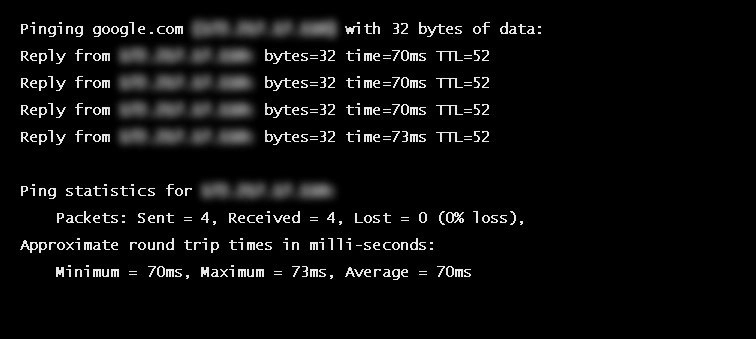
Example of a ping to google.com
Factors Influencing RTT
Actual round trip time can be influenced by:
- Distance – The length a signal has to travel correlates with the time taken for a request to reach a server and a response to reach a browser.
- Transmission medium – The medium used to route a signal (e.g., copper wire, fiber optic cables) can impact how quickly a request is received by a server and routed back to a user.
- Number of network hops – Intermediate routers or servers take time to process a signal, increasing RTT. The more hops a signal has to travel through, the higher the RTT.
- Traffic levels – RTT typically increases when a network is congested with high levels of traffic. Conversely, low traffic times can result in decreased RTT.
- Server response time – The time taken for a target server to respond to a request depends on its processing capacity, the number of requests being handled and the nature of the request (i.e., how much server-side work is required). A longer server response time increases RTT.
See how Imperva CDN can help you with website performance.
Reducing RTT Using a CDN
A CDN is a network of strategically placed servers, each holding a copy of a website’s content. It’s able to address the factors influencing RTT in the following ways:
- Points of Presence (PoPs) – A CDN maintains a network of geographically dispersed PoPs—data centers, each containing cached copies of site content, which are responsible for communicating with site visitors in their vicinity. They reduce the distance a signal has to travel and the number of network hops needed to reach a server.
- Web caching – A CDN caches HTML, media, and even dynamically generated content on a PoP in a user’s geographical vicinity. In many cases, a user’s request can be addressed by a local PoP and does not need to travel to an origin server, thereby reducing RTT.
- Load distribution – During high traffic times, CDNs route requests through backup servers with lower network congestion, speeding up server response time and reducing RTT.
- Scalability – A CDN service operates in the cloud, enabling high scalability and the ability to process a near limitless number of user requests. This eliminates the possibility of server side bottlenecks.
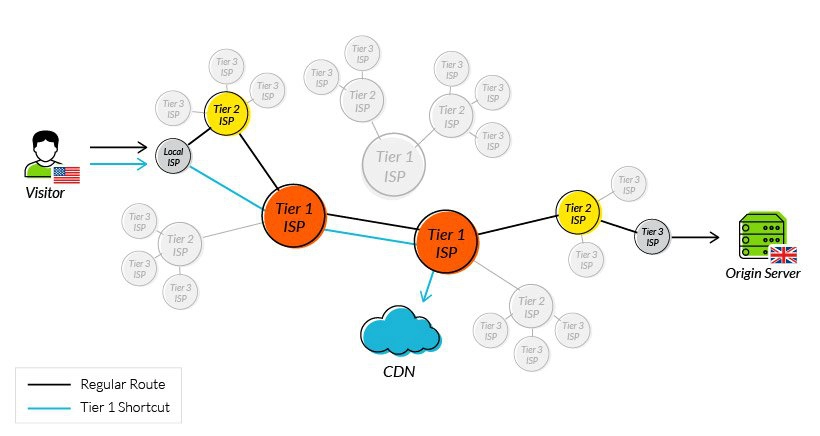
Using tier 1 access to reduce network hops
One of the original issues CDNs were designed to solve was how to reduce round trip time. By addressing the points outlined above, they have been largely successful, and it’s now reasonable to expect a decrease in your RTT of 50% or more after onboarding a CDN service.
Latest Blogs

Grainne McKeever
Feb 26, 2024 3 min read

Erez Hasson
Jan 18, 2024 3 min read

Luke Richardson
Dec 27, 2023 6 min read

Dec 21, 2023 2 min read

Dec 13, 2023 5 min read

Dec 7, 2023 6 min read

- Imperva Threat Research

, Gabi Stapel
Nov 8, 2023 13 min read

Nov 7, 2023 1 min read
Latest Articles
- Network Management
169.7k Views
164.9k Views
152.9k Views
100.4k Views
98.3k Views
58.7k Views
54.6k Views
2024 Bad Bot Report
Bad bots now represent almost one-third of all internet traffic
The State of API Security in 2024
Learn about the current API threat landscape and the key security insights for 2024
Protect Against Business Logic Abuse
Identify key capabilities to prevent attacks targeting your business logic
The State of Security Within eCommerce in 2022
Learn how automated threats and API attacks on retailers are increasing
Prevoty is now part of the Imperva Runtime Protection
Protection against zero-day attacks
No tuning, highly-accurate out-of-the-box
Effective against OWASP top 10 vulnerabilities
An Imperva security specialist will contact you shortly.
Top 3 US Retailer
- Aksela | Web Application Security
- WAF Security
- DDoS Protection
- Security Operations Center SOC
- Content Delivery Network
- API Caching
- Video And Streaming CDN
- Image Optimization
- Private CDN
- Stook | Cloud Object Storage
- Why Medianova
- Press Releases
- White Papers
- Customer Journey Map
- Integrations
- Support Request
- Software Learning
- Get Started For Free

All You Need to Know About Round-Trip Time
What exactly is rtt .
Round-trip time (RTT) is a networking metric that measures in milliseconds the time it takes for a data packet to be sent and the time it takes for an acknowledgment of that signal to be received . The propagation times for the paths between the two communication endpoints are included in this time delay. As you can imagine, a CDN’s primary goal is to reduce it. Also, latency improvements can be measured by reducing RTT.
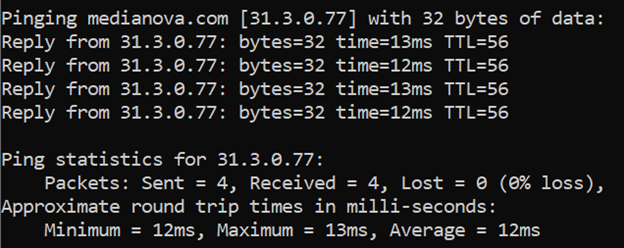
Ping, Latency and now the RTT. It brings out this question: Are they the same?
The ping utility, which is found on almost every computer, is a method of estimating round-trip time. Ping tests, on the one hand, are typically performed within a transport protocol that employs ICMP packets. Network latency, on the other hand, is closely related, but it is not the same as RTT. Latency is the amount of time it takes for a data packet to travel from one endpoint to the other. The processing delay at the echo endpoint is included in Round Trip Time.
What is a good RTT?
Every application will have its own set of requirements, and it is nearly impossible to give a specific time frame. What is tolerable in one use may be intolerable in another. Still, we can approximately say that your users should have an RTT of at least 95ms for normal application usage and a maximum of 190ms before your application degrades the quality of your service.
What are the most prevalent factors influencing Round Trip Time?
Potential elements that may have an impact on RTT are distance, local area network traffic and response time.
- Distance : CDN optimized connections can minimize the number of hops necessary to reach a destination; nonetheless, network connectivity is limited by distance.
- LAN Traffic : Because of the quantity of traffic on the local area network, connections might be barriers before they ever reach the wider Internet network.
- Response Time: The time it takes a target server to reply to a request is determined by its processing capability, the number of requests processed, and the type of the request. As a result, a longer server response time raises RTT.
Reducing Round Trip Time with a Content Delivery Network (CDN)
A content delivery network (CDN) is a network of strategically positioned servers, each carrying a duplicate of a website’s content. It is capable of addressing the following elements that impact RTT:
First of all, each PoP that contains cached copies of site content is responsible for interacting with site users in their immediate location. There are less signal transmission distance and network hops to reach a server. Also, on a PoP in the user’s geographic area, CDNs cache HTML, media, and even dynamically generated content (DGC). Users’ requests can be handled by a local PoP, decreasing RTT.
Moreover, TLS 1.3 decreases web page latency by shortening the RTT required to connect the client and server. TLS 1.3 has been updated with new digital signature algorithms. With 1.3, the first support for 1-RTT Handshake and 0-RTT were added. This feature is provided to our customers free of charge on the Medianova CDN platform.
Last but not least, another impact worth mentioning is speeding up server response times and reducing RTT by using Anycast. In most cases, Anycast directs incoming traffic to the nearest data center with less network congestion during peak traffic periods.
At Medianova, we focus on all the ways to accelerate, enhance and secure your content delivery. Get in touch with us to learn more about how Medianova can help you deliver the best online experiences.

Round-Trip Time (RTT)
Last Edited
In the intricate domain of computer networking, Round-Trip Time, popularly known as RTT, plays an instrumental role. RTT signifies the time it takes for a data packet to travel from a source to a destination and back again. It serves as a key performance metric in networking, helping diagnose network speed and efficiency.

What is RTT?
To understand what RTT is, envision playing catch with a ball. You throw the ball (this represents the data packet), and your friend catches it (this is the packet reaching its destination). Then, your friend throws the ball back to you (the packet’s return journey). The total time from the initial throw to catching the ball again is akin to RTT in networking.
RTT is not about how quickly the ball is thrown or caught; rather, it’s about the total duration of the journey. Similarly, in the digital world, RTT measures the full journey of a data packet, irrespective of the data size or transmission speed.
The Importance of Round-Trip Time
RTT is pivotal for network administrators because it helps to measure network latency or delay. It’s a vital metric used to determine the performance of network connections, allowing administrators to identify potential issues and gauge the quality of the network.
A lower Round-Trip Time indicates a faster connection, resulting in improved data transfer and a superior user experience. Conversely, a high RTT may suggest network congestion, poor routing, or other issues leading to increased latency.
How to Measure RTT?
A common method to measure RTT is by using the ‘ping’ command . This command sends an Internet Control Message Protocol (ICMP) request to a specified server, which then sends an ICMP reply back. The time it takes for this round-trip journey is the RTT, typically measured in milliseconds (ms).
Another method involves using Traceroute, a command-line tool that displays the path that a packet takes to reach its destination, recording the latency at each hop.
RTT and Its Impact on Applications
RTT is particularly critical for real-time applications such as video conferencing, VoIP calls, online gaming, and live streaming. High Round-Trip Time values in these applications can lead to noticeable delays, buffering, and synchronization issues, disrupting the user experience.
In non-real-time applications, like email or file transfer, high RTT might not be immediately noticeable to the user but could slow down overall data transfer rates.
Understanding RTT is a fundamental aspect of grasping how networks operate. It allows us to measure and diagnose network performance, directly impacting how we experience the internet and online services. By paying attention to RTT, network administrators can ensure optimal network performance, paving the way for efficient, seamless digital communication.
- RFC 7982 – Measurement of Round-Trip Time and Fractional Loss Using Session Traversal Utilities for NAT (STUN)

Object Storage Enables Effortless Migration of Game Packages
Learn how the CDNetworks’ team helped the customer address the issues and quickly set up game storage in China.

Global To China Solutions
Companies looking to grow their business in China are faced with a number of daunting and complex laws and regulations.

eBook for Travel Industry
Beating the Bots: The most common issues impacting the online travel industry and how to combat them.

Entertaiment Live Streaming Solution
Empowers live streamers to deliver the best viewing experience and real-time engagement anytime, anywhere.
CDNetworks successfully mitigated a blockchain DDoS attack on the eve of Bitcoin ETF approval, peaking at 1.025 Tbps - Learn how we mitigated
Media Delivery Glossary
Glossary » Media Delivery » Round Trip Time (RTT)
Round Trip Time (RTT)
Round-Trip Time (RTT) is a crucial metric in network performance, representing the total time it takes for a signal to travel from a sender to a recipient and back again. Typically measured in milliseconds, RTT is an essential factor in determining the efficiency and responsiveness of network communications, particularly in web applications.
In the context of web browsing, RTT is the duration from when a browser sends a request to a server until it receives a response. This measure is integral to understanding the performance of web applications as it directly impacts the user experience. A lower RTT signifies faster communication between the browser and the server, leading to quicker page loads and a more responsive interaction for the user.
RTT is often mentioned alongside Time to First Byte (TTFB), another critical performance metric. While TTFB measures the time from the initial request to the first byte of the response, RTT accounts for the entire round-trip journey. Together, these metrics provide a comprehensive picture of network latency and the overall speed of a web application.
Several factors can influence RTT, including the physical distance between the client and the server, the quality and capacity of the network connection, and the efficiency of the server. Network congestion and routing paths also play a significant role. For instance, a request that has to pass through multiple routers or switches will typically have a higher RTT due to the increased processing time at each hop.
In practical applications, RTT is used to optimize network configurations and improve the performance of web applications. For instance, content delivery networks (CDNs) are strategically positioned to reduce RTT by serving content from locations closer to the end-user. Additionally, understanding RTT can help diagnose network issues, such as identifying bottlenecks or suboptimal routing paths that may affect performance.
In conclusion, Round-Trip Time is a fundamental measure in assessing the performance of network communications. It provides valuable insights into the efficiency of data transmission over a network, directly impacting the user experience in web applications. Minimizing RTT is a crucial objective in network and application optimization strategies.
Learn More About Media Delivery
Images and Resolutions
Media Streaming
Video Streaming
What Is a Media Server?
Network Latency
Real-Time Streaming Protocol (RTSP)
- Documentation
- Screenshots
- Try for Free
The Monitoring Agent
4 types of Agents to help you measure network and application performance.
Network Device Monitoring
Monitor the health of devices like Firewalls, Routers, Switches, Wifi APs and more.
Network Performance Monitoring
Monitor network performance to find and fix issues before they affect users.
Public Monitoring Agents Directory
Proactively Monitor network performance with these service providers.
Understanding & Reducing Network Round-Trip Time (RTT in Networking)
Table of contents.
In the dynamic realm of modern business operations, the heartbeat of connectivity relies on the seamless flow of information across networks. Network administrators and IT professionals, entrusted with the pivotal responsibility of maintaining these vital lifelines, understand the significance of every nanosecond.
In a world where time equates to money and efficiency is non-negotiable, the RTT in networking emerges as a pivotal metric. It represents the time taken for a packet of data to travel from its source to its destination and back again, reflecting the responsiveness and effectiveness of your network infrastructure. As businesses increasingly rely on cloud-based applications, remote collaboration tools, and real-time data analytics, the optimization of RTT has become more critical than ever.
In this comprehensive exploration, we will decode the intricacies of Network Round-Trip Time, demystifying its importance and empowering network administrators and IT professionals with actionable insights to reduce RTT and enhance network performance.
What is Network Round-Trip Time (RTT in Networking)?
First, let’s make sure we’re all on the same page.
Network Round-Trip Time (RTT) in networking, also commonly referred to as Round-Trip Latency or simply Latency, is a crucial metric that measures the time it takes for a packet of data to travel from its source to its destination and back again to the source . RTT is typically expressed in milliseconds (ms) and is a fundamental aspect of network performance.
Here's a breakdown of what RTT encompasses:
- Transmission Time : This is the time it takes for a packet of data to travel from the sender to the receiver. It includes the propagation time (the time it takes for the signal to physically travel through the network medium) and the processing time (the time it takes for routers, switches, and other network devices to handle the packet).
- Propagation Delay : This is the time it takes for an electrical or optical signal to travel over the physical medium, such as a copper or fibre-optic cable. Propagation delay depends on the distance the signal needs to cover and the speed of light or electricity in the medium.
- Queuing and Processing Delay : As data packets pass through routers and switches in a network, they may spend some time in queues waiting for their turn to be processed. This queuing and processing delay can vary based on network congestion and the efficiency of network devices.
In summary, Network Round-Trip Time (RTT) is a key metric in networking that measures the time it takes for data to travel from its source to its destination and back, encompassing transmission time, propagation delay, and queuing/processing delay. It plays a significant role in determining the responsiveness and efficiency of networked applications and services.
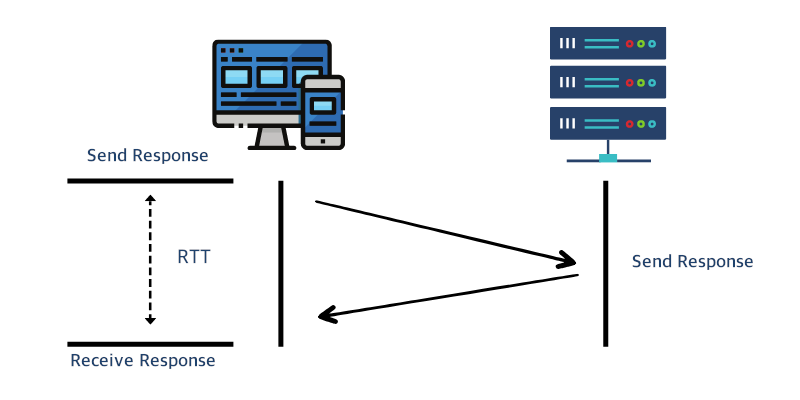
The Role of RTT (Network Round-Trip Time) in Network Responsiveness
Network responsiveness, often measured by RTT, is the cornerstone of user satisfaction and efficient operations.
RTT is a critical factor in network performance because it directly impacts the responsiveness of network applications and services. Low RTT values indicate that data can travel quickly between endpoints, resulting in faster response times for applications and a more seamless user experience. On the other hand, high RTT values can lead to delays and sluggish performance.
Reducing RTT is essential in scenarios where real-time communication, online gaming, video conferencing, or the timely delivery of data is crucial. Network administrators and IT professionals often work to optimize RTT by employing various strategies such as using content delivery networks (CDNs), minimizing network congestion, and optimizing routing paths.
- User Expectations : Today's users have high expectations for network responsiveness. Whether it's loading a web page, streaming a video, or making a VoIP call, users demand minimal delays. A low RTT ensures that users experience quick response times, leading to seamless and satisfactory interaction with applications and services.
- Real-Time Applications : Many critical business applications, such as video conferencing, online collaboration tools, and financial trading platforms, require real-time data exchange. RTT directly impacts the effectiveness of these applications. A shorter RTT means that data reaches its destination faster, enabling real-time interactions without noticeable delays.
I. Network Round-Trip Time (RTT) and User Experience
User experience is a key driver of customer satisfaction and loyalty. RTT plays a pivotal role in shaping this experience.
- Website Performance : For businesses with an online presence, website performance is paramount. A website with low RTT loads quickly, ensuring that visitors can access information, make purchases, or engage with content without frustrating delays. Studies have shown that longer page load times due to high RTT can result in higher bounce rates and decreased conversions.
- Video and Media Streaming : In an era of video marketing and content consumption, RTT directly influences the quality of video streaming. Lower RTT values mean faster buffer-free streaming, enhancing the viewer's experience and reducing the likelihood of video interruptions.
II. Network Round-Trip Time’s (RTT) Impact on Business Operations
Beyond user experience, RTT has a profound impact on various aspects of business operations:
- Productivity : In a remote or hybrid work environment, where employees rely on cloud-based applications and data access, RTT can significantly impact productivity. Sluggish network performance due to high RTT values can lead to frustration, downtime, and decreased efficiency.
- Data Transfer : Businesses often need to transfer large volumes of data between locations or to the cloud. High RTT can lead to slow data transfer speeds, potentially affecting data backup, disaster recovery, and the ability to access critical information in a timely manner.
- Customer Service : For businesses that provide customer support or run call centers, low RTT is essential for clear and uninterrupted VoIP calls. High RTT can lead to call dropouts, poor call quality, and dissatisfied customers.
- E-commerce : In the world of e-commerce, where every millisecond counts, RTT can impact sales and customer retention. Slow-loading product pages and checkout processes due to high RTT values can result in abandoned shopping carts and lost revenue.
Understanding the significance of RTT in modern networking is not just a technical matter; it's a fundamental aspect of delivering a positive user experience, maintaining productivity, and ensuring the seamless operation of critical business processes. Network administrators and IT professionals must prioritize RTT optimization to meet the demands of today's digital business landscape.
Ready to Optimize Your Network's Round-Trip Time? Try Obkio Today!
Are you eager to take control of your network's performance and reduce Round-Trip Time (RTT) to boost productivity and enhance user experiences? Look no further than Obkio's Network Performance Monitoring tool, the ultimate solution for network administrators and IT professionals.

Why Choose Obkio:
- Real-Time Monitoring : Obkio provides real-time visibility into your network, allowing you to identify latency bottlenecks and pinpoint performance issues as they happen.
- User-Friendly Interface : With an intuitive and user-friendly interface, Obkio makes it easy to monitor your network's RTT and other critical metrics without the need for complex configurations.
- Actionable Insights : Obkio offers actionable insights and recommendations to help you optimize your network's performance, reduce RTT, and ensure seamless business operations.
- Customized Alerts : Set up custom alerts to be notified of performance deviations, ensuring that you can proactively address issues before they impact your users.
Unlock the Full Potential of Your Network with Obkio. Get Started Today!
Don't let network latency hold your business back. Take the first step towards optimizing your network's Round-Trip Time and providing an exceptional user experience. Try Obkio's Network Performance Monitoring tool now and experience the difference.

Measuring and Calculating Network Round-Trip Time: How to Calculate RTT
While understanding the significance of RTT is vital, the ability to quantify and interpret it accurately is equally crucial for network administrators and IT professionals.
In this section, we’ll equip you with the knowledge and tools necessary to measure, calculate, and make sense of RTT metrics effectively. RTT measurement is not merely a technical exercise; it's a strategic endeavour that empowers you to fine-tune your network for peak performance, deliver an exceptional user experience, and ensure the seamless operation of critical business processes.
So, join us as we explore the RTT formula, discover the range of tools at your disposal for RTT measurement, and learn the art of interpreting RTT metrics.
I. Understanding the Network RTT Formula
The RTT formula is a fundamental concept for anyone aiming to measure and manage network latency effectively. It provides a straightforward way to calculate the Round-Trip Time between two endpoints in a network.
The formula for RTT is as follows:
RTT = (t2 - t1) + (t4 - t3)
- t1 : The time at which the sender sends the packet.
- t2 : The time at which the sender receives an acknowledgment (ACK) from the receiver.
- t3 : The time at which the receiver receives the packet.
- t4 : The time at which the receiver sends the ACK back to the sender.
Understanding this formula allows you to measure RTT manually by recording these timestamps. In practice, however, RTT is often measured automatically using specialized tools and software.
I. Tools for Measuring Network RTT
Accurate RTT measurement is crucial for network administrators and IT professionals. Fortunately, a range of tools and methods are available to simplify this process:
- Network Monitoring Software : Comprehensive network monitoring solutions, such as Obkio's Network Performance Monitoring tool , offer real-time RTT measurement and historical data tracking. These tools provide insights into RTT trends, allowing you to identify performance fluctuations and optimize network resources.
- Ping : The ping command is a simple and widely used tool for measuring RTT. It sends ICMP echo requests to a destination and records the time it takes for responses to return. While ping provides basic RTT information, it may not be suitable for more detailed analysis.
- Traceroute : Traceroute is another command-line tool that helps you trace the path a packet takes to reach its destination. It provides information about each hop along the route, including RTT values. Traceroute is useful for diagnosing latency issues and identifying bottlenecks in the network.
- Packet Analyzers : Packet analyzers like Wireshark capture network packets and provide detailed analysis, including RTT calculations. They are invaluable for diagnosing complex network issues but require a deeper understanding of packet-level data.
- Cloud-Based Monitoring Services : Cloud-based services can measure RTT from multiple locations globally, offering a broader perspective on network performance. These services often include user-friendly dashboards and alerting features.

III. Interpreting Network RTT Metrics
Interpreting RTT metrics is essential for making informed decisions about network optimization. Here's how to understand the data:
- Baseline RTT : Establish a baseline RTT for your network under normal operating conditions. This baseline serves as a reference point for identifying deviations and potential issues.
- Variability : Monitor the variability of RTT values over time. Consistently high or fluctuating RTT can indicate network congestion, equipment problems, or other performance bottlenecks.
- Comparing RTT Metrics : Compare RTT metrics between different endpoints, routes, or network segments. This can help pinpoint specific areas of concern and prioritize optimization efforts.
- Thresholds and Alerts : Set RTT thresholds and network monitoring alerts to be notified when latency exceeds acceptable levels. Proactive alerting allows you to address performance issues before they impact users.
- Root Cause Analysis : When RTT metrics indicate performance problems, use additional tools and diagnostics to perform a root cause analysis. Isolate the source of latency and implement corrective measures.
Interpreting RTT metrics effectively empowers network administrators and IT professionals to make data-driven decisions, optimize network performance, and deliver a seamless user experience.
In conclusion, understanding the RTT formula, utilizing measurement tools, and interpreting RTT metrics are essential steps in managing and improving network latency. These skills enable network professionals to diagnose issues, identify opportunities for optimization, and ensure efficient network performance.
IV. How to Calculate RTT in Networking: An Example
Let's walk through a simple example of calculating Network Round-Trip Time (RTT) for a packet of data travelling between two devices.
Suppose you have a sender ( Device A ) and a receiver ( Device B ) connected to the same network. You want to measure the RTT for a packet of data sent from Device A to Device B and back.
Here are the key timestamps you'll need to measure or record:
- t1 : The time at which Device A sends the packet.
- t2 : The time at which Device A receives an acknowledgment (ACK) from Device B.
- t3 : The time at which Device B receives the packet.
- T4 : The time at which Device B sends the ACK back to Device A.
Now, let's assume the following timestamps:
- t1 : 12:00:00.000 (Device A sends the packet)
- t2 : 12:00:00.150 (Device A receives the ACK from Device B)
- t3 : 12:00:00.200 (Device B receives the packet)
- t4 : 12:00:00.350 (Device B sends the ACK back to Device A)
Now, you can use the RTT formula to calculate the Round-Trip Time:
Plug in the values:
RTT = (12:00:00.150 - 12:00:00.000) + (12:00:00.350 - 12:00:00.200)
RTT = 0.150 seconds + 0.150 seconds
RTT = 0.300 seconds
So, in this example, the calculated Network Round-Trip Time (RTT) for the packet travelling between Device A and Device B is 0.300 seconds, or 300 milliseconds (ms).
This RTT value represents the time it took for the data packet to travel from Device A to Device B and back, including the time it spent in transit and the time it took for the acknowledgment to return.
In this article, we explore the importance of testing network latency for businesses and provide tools and techniques for accurately measuring latency.
How to Measure Network Round-Trip Time with NPM Tools
When it comes to measuring and optimizing Network Round-Trip Time (RTT), Network Performance Monitoring (NPM) tools are your go-to.
NPM tools provide real-time visibility into network performance and continuously and comprehensively monitor various aspects of a network, allowing network administrators to track RTT metrics at multiple points in the network infrastructure.
By offering a granular view of RTT, NPM tools help identify performance bottlenecks, allowing for swift diagnosis and targeted optimization. Additionally, NPM tools often include alerting features that notify administrators when RTT exceeds predefined thresholds, enabling proactive problem resolution before end-users experience the impact.
Moreover, NPM tools are equipped with historical data analysis capabilities, allowing network professionals to identify trends and patterns in RTT values. By identifying long-term RTT patterns, administrators can make informed decisions about capacity planning, infrastructure upgrades, or routing optimization to ensure consistent low-latency network performance.
In a world where network responsiveness is crucial for user satisfaction and business productivity, NPM tools are invaluable for network administrators and IT professionals aiming to maintain optimal RTT and deliver a seamless user experience. Let’s learn how to deploy them!
Step 1. Deploy A Network Performance Monitoring Tool with RTT Monitoring Features
High RTT can lead to delays and sluggish network performance - but how can you know the extent of the problem?
The most accurate way to measure RTT and other key network metrics is by using a Synthetic Network Performance Monitoring Software, like Obkio.
Unlike standalone RTT monitoring tools, Obkio provides a holistic approach to network performance analysis, making it the best choice for measuring RTT and network performance as a whole. With Obkio, gain access to real-time monitoring and reporting features that allow them to measure RTT across their entire network infrastructure, including routers, switches, and end-user devices.
This end-to-end network monitoring tool not only identifies RTT issues but also provides valuable insights into latency, packet loss, bandwidth utilization and more.
Obkio continuously measures network metrics like network RTT by:
- Using Network Monitoring Agents in key network locations
- Simulate network traffic with synthetic traffic and synthetic testing
- Sending packets every 500ms to measure the round trip time it takes for data to travel
- Catch RTT and other network issues affecting key applications and services
Step 2. Measure Round-Trip Time in All Network Locations
Persistent and erratic spikes in Network Round-Trip Time (RTT) measurements are indicative of substantial performance challenges within your network, demanding immediate attention. To pinpoint and resolve these irregularities, implementing RTT monitoring is an indispensable step.
Obkio’s Network Monitoring Solution will measure RRT and other network metrics by sending and monitoring data packets through your network every 500ms using Network Monitoring Agents . The Monitoring Agents are deployed at key network locations like head offices, data centers, and clouds and continuously measure the amount of time it takes for data to travel across your network.
This is extremely important when monitoring RTT and addressing spikes to maintain network efficiency and a smooth user experience, especially in scenarios where real-time data exchange, applications, and services are critical.
For example , you can measure network RTT between your head office and the Microsoft Azure cloud, or even between Azure and your data center.
To deploy monitoring in all your network locations, we recommend deploying:
- Local Agents : Installed in the targeted office location experiencing performance issues or latency spikes. There are several Agent types available (all with the same features), and they can be installed on MacOS, Windows, Linux and more.
- Public Monitoring Agent : These are deployed over the Internet and managed by Obkio. They compare performance up to the Internet and quickly identify if the performance issue is global or specific to the destination. For example, measure RTT between your branch office and Google Cloud .
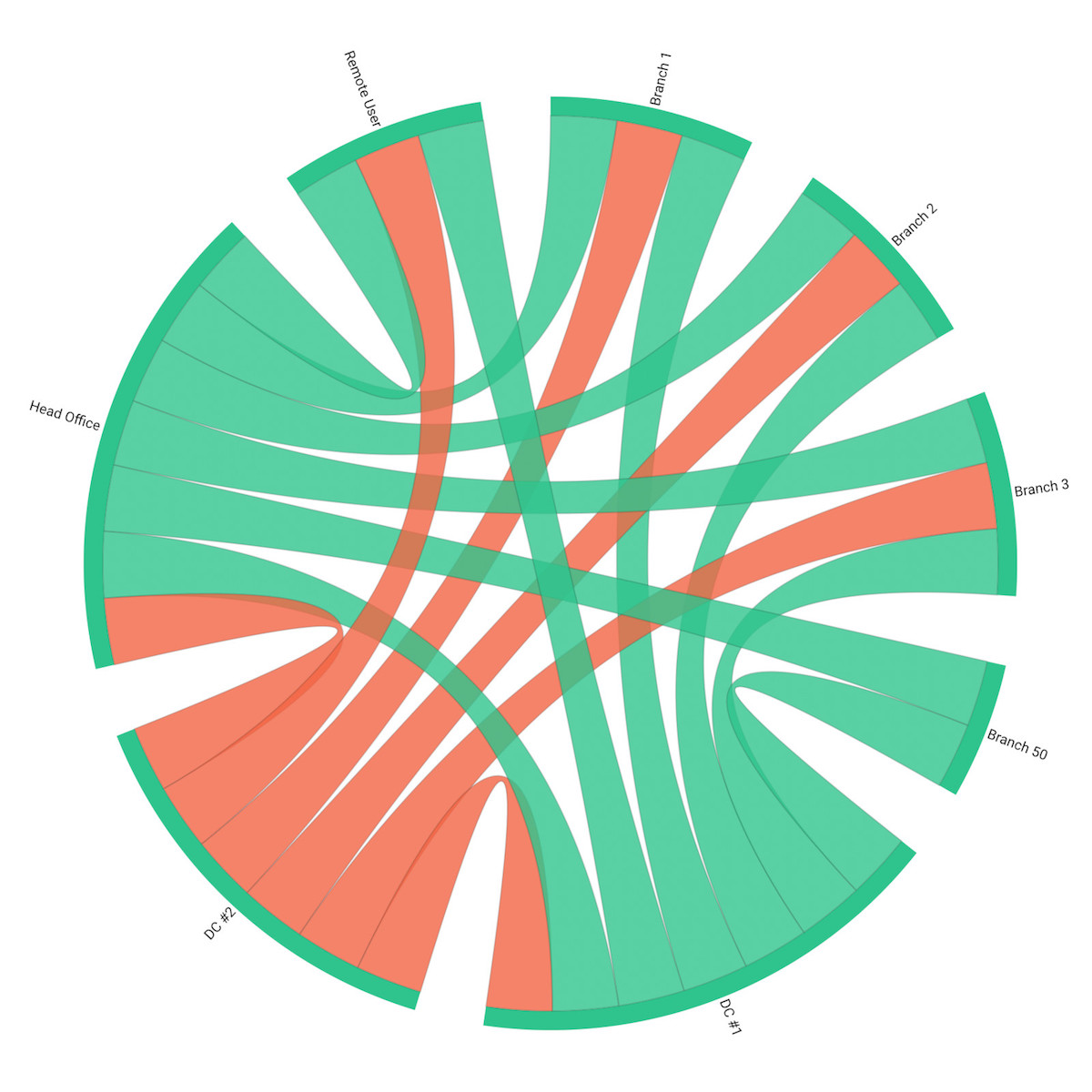
Step 3. Measure Round-Trip Time for Network Devices
Network Device Monitoring is also crucial for accurately measuring and managing Network Round-Trip Time (RTT). Network devices, such as routers, switches, and firewalls, play a significant role in determining the latency and RTT experienced by data packets as they traverse the network.
Obkio’s Network Device Monitoring feature is a fast and easy solution to get detailed information about the health of your core network devices. Used with the end-to-end Network Performance Monitoring feature, Network Device Monitoring with SNMP Polling helps IT teams quickly and proactively pinpoint issues with devices like firewalls, routers, switches and Wi-Fi access points.
Network devices are key points of control and routing within a network. Monitoring these devices allows you to gain insights into their performance, such as how efficiently they process and forward data packets. Device monitoring helps identify issues like high CPU utilization, memory constraints, or network interface errors, which can all contribute to increased RTT.
Here are the key network devices you should consider monitoring when measuring network round-trip time:
- Routers : Routers are pivotal devices in network traffic management. They determine the path data packets take between networks and subnetworks. Monitoring routers helps identify congestion points, routing issues, and overall device performance.
- Switches : Network switches are responsible for forwarding data packets within a local network (LAN). Monitoring switches helps ensure that LAN traffic is efficiently handled and doesn't introduce unnecessary RTT.
- Firewalls : Firewalls are essential for network security but can also introduce latency. Monitoring firewalls helps verify that they're processing data packets efficiently and not creating undue RTT delays.
- Load Balancers : Load balancers distribute network traffic across multiple servers or resources to ensure load distribution and fault tolerance. Monitoring load balancers helps maintain even traffic distribution and low RTT.
- Gateways : Gateways connect different networks, such as LANs to the internet. Monitoring gateways is essential for ensuring data packets are efficiently routed between internal networks and external destinations.
- WAN Optimization Devices : These devices are commonly used in wide-area networks (WANs) to reduce latency and optimize data transfer. Monitoring WAN optimization devices ensures they're operating as intended to minimize RTT.
- Access Points (APs) : In wireless networks, APs play a critical role in data transmission. Monitoring APs helps maintain consistent wireless network performance, minimizing RTT for mobile or remote users.
- DNS Servers : DNS (Domain Name System) servers translate domain names into IP addresses. Monitoring DNS servers ensures that DNS resolution doesn't introduce delays when clients access network resources.
- Network Endpoints : Monitoring the performance of endpoints (e.g., servers, workstations, and user devices) is vital for understanding how network devices affect RTT from the user's perspective.
- Virtualization and SDN Controllers : In virtualized or software-defined networks, controllers manage network resources and routing. Monitoring these controllers helps ensure efficient data flow and low RTT.
To comprehensively measure and optimize RTT, it's essential to monitor a variety of network devices . The choice of devices to monitor may depend on the specific characteristics of your network and the critical points for your organization.

Step 4. Collect Network Round-Trip Time Measurements
Once you’ve set up your Monitoring Agents for network latency monitoring , they continuously measure metrics like RTT measure and collect data, which you can easily view and analyze on Obkio’s Network Response Time Graph.
Measure RTT throughout your network with updates every minute. This will help you understand and measure good round-trip time measurements for different applications vs. poor latency. If your RTT levels go from good to poor, you can also further drill down to identify exactly why RTT issues are happening, where they’re happening, and how many network locations they’re affecting.
To more accurately measure RTT in your network, and receive alerts when latency measurements are poor, Obkio sends alerts based on historical data and not just static thresholds.
As soon as there’s a deviation in the historical data, and your network is experiencing poor RTT measurements, Obkio sends you an alert.
It’s as simple as that
Step 5. Monitor More Network Metrics Alongside Network Round-Trip Time
Once deployed, Obkio’s Monitoring Agents will begin exchanging synthetic traffic to continuously measure network performance and core network metrics .
When monitoring network performance and assessing the health of your network, it's important to measure a range of network metrics alongside Network Round-Trip Time (RTT) to gain a comprehensive understanding of the network's behaviour and potential issues. Here are several key network metrics to consider:
- Packet Loss : Packet loss indicates the percentage of data packets that fail to reach their destination. High packet loss can significantly impact the quality of network services and applications.
- Jitter : Jitter is the variation in latency or RTT. Consistent RTT values are desirable, but high jitter can lead to unpredictable network performance, which is problematic for real-time applications like VoIP and video conferencing.
- Bandwidth Utilization : Monitoring bandwidth usage helps you identify periods of congestion and overutilization, which can lead to increased RTT. By monitoring bandwidth, you can proactively manage network capacity.
- Throughput : Throughput measures the rate at which data is transmitted over the network. It's essential for assessing the actual data transfer capacity of your network, especially for large file transfers or media streaming.
- Error Rate : The network error rate indicates the number of data packets with errors or corruption. High error rates can lead to retransmissions, increasing latency and packet loss.
- QoS Metrics : Quality of Service (QoS) metrics include parameters like latency, jitter, and packet loss, specific to certain traffic types. Monitoring QoS compliance is essential for prioritizing critical applications and ensuring they meet performance requirements.
- Device Performance : Monitoring the performance of network devices such as routers, switches, and firewalls is crucial. High CPU usage , memory issues, or hardware problems can impact network performance and increase RTT.
- Availability and Uptime : Monitoring network availability and network uptime is essential for identifying periods of network unavailability or downtime, which can impact services and applications.
By measuring these network metrics alongside RTT, you can gain a holistic view of your network's performance, detect issues promptly, and proactively optimize network resources to provide a seamless user experience and support critical business operations.
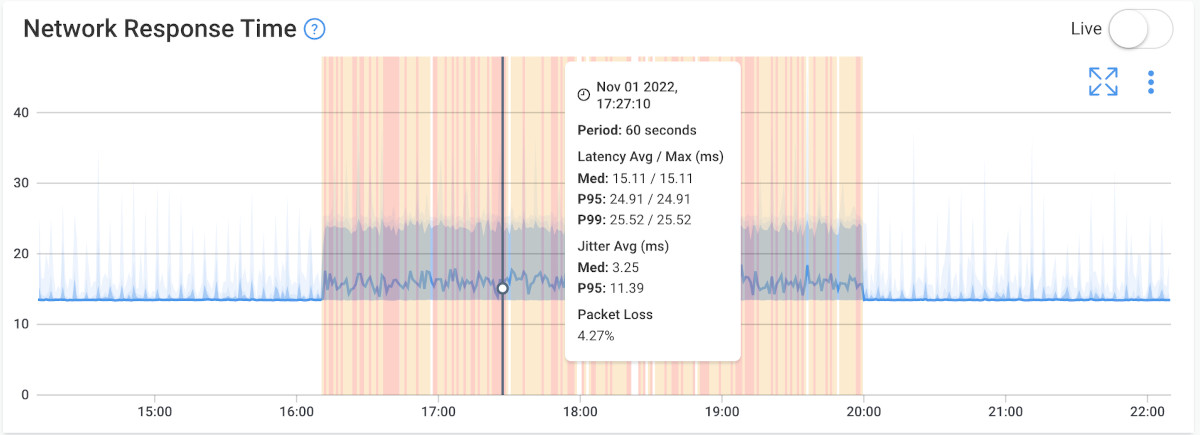
Understanding Good vs. Bad Network Round-Trip Time Measurements
In the intricate world of networking, the metric known as Network Round-Trip Time (RTT) serves as a crucial barometer of performance. However, RTT is not a one-size-fits-all metric, and its evaluation must be tailored to the specific needs and demands of a network or application.
In this section, we delve into the nuanced realm of RTT measurements, deciphering what constitutes good and bad readings, and how these metrics reverberate through the fabric of network performance.
Good and bad RTT measurements are relative and depend on the specific context and requirements of a network or application. What is considered good or bad RTT can vary based on factors such as the type of network, the application's sensitivity to latency, and the expectations of users. However, here are some general guidelines to consider:
I. Good Network RTT Measurements
- Low and Consistent : Good RTT measurements typically exhibit low and consistent values. Low RTT indicates that data is transmitted quickly, providing a responsive user experience. Consistency ensures that users can rely on predictable network performance.
- Match Application Requirements : Good RTT measurements should meet or exceed the requirements of the applications and services being used. For example, real-time applications like video conferencing or online gaming often require RTT values below 100 milliseconds to provide a seamless experience.
- Minimal Jitter : Good RTT measurements have minimal jitter, meaning that there is little variation in RTT values. Jitter can disrupt real-time applications, so a stable and low-latency network is desired.
II. Bad Network RTT Measurements:
- High and Fluctuating : Bad RTT measurements typically exhibit high values and significant fluctuations. High RTT values can lead to sluggish network performance and application responsiveness, while fluctuations introduce unpredictability.
- Exceed Application Tolerances : For some applications, any RTT values beyond specific thresholds can be considered bad. For example, an online multiplayer game might become unplayable with RTT exceeding 200 milliseconds.
- Frequent Packet Loss : Consistent packet loss and retransmissions can lead to bad RTT measurements. Packet loss is a sign of network congestion or instability, and it can severely impact network performance.
- Long-Term Performance Issues : Consistently bad RTT measurements over an extended period, even if they are not extremely high, may indicate underlying network issues that need to be addressed. It's essential to identify and resolve long-term performance problems to maintain a reliable network.
In summary, good RTT measurements are characterized by low, consistent values that meet the requirements of the network's applications, with minimal jitter. Bad RTT measurements, on the other hand, involve high, fluctuating values, packet loss, and latency that exceeds application tolerances. To assess RTT measurements, it's important to consider the specific network requirements and the impact of latency on user experience in your particular environment.

Identifying, Troubleshooting, and Common Network Round-Trip Time (RTT) Issues
In the world of networking, Network Round-Trip Time (RTT) serves as a vital performance indicator. When RTT issues arise, they can lead to sluggish network responsiveness and user dissatisfaction. This section is your guide to identifying and troubleshooting common RTT problems that can affect network performance.
We'll dive into the practical aspects of recognizing RTT issues, whether through real-time monitoring or user feedback. We'll also explore the common culprits behind elevated RTT, such as congestion and configuration problems.

I. Identifying Network RTT Issues
- Real-time Monitoring : Regularly monitor RTT using network performance monitoring tools, like Obkio NPM . These tools provide real-time data on RTT, enabling you to detect anomalies or spikes that might indicate issues.
- Baseline Measurement : Establish a baseline for expected RTT values in your network. Deviations from this baseline can be an early indicator of RTT problems.
- User Feedback : Listen to user complaints or feedback. Slow application response times or connectivity issues reported by users can be indicative of RTT issues.
- Historical Analysis : Analyze historical RTT data to identify patterns or trends. Consistent RTT issues at specific times or on particular network segments can point to the source of the problem.
- Network Topology Review : Examine your network topology to identify potential bottlenecks or congestion points that may contribute to high RTT.
II. Uncovering The Most Common Network RTT Issues
- Network Congestion : Heavy network traffic can lead to network congestion , queuing delays, and packet loss, resulting in increased RTT. Implement Quality of Service (QoS) to prioritize essential traffic and reduce congestion.
- Long Geographic Distance : Data travelling over long distances, especially in wide-area networks (WANs), can experience high propagation delay, contributing to elevated RTT. Consider implementing content delivery networks (CDNs) to reduce the impact of distance.
- Hardware and Configuration Problems : Outdated or misconfigured network devices, such as routers and switches, can lead to performance issues and high RTT. Regularly review and update hardware and configurations to address these problems.
- Packet Loss : Packet loss , where data packets are dropped or need to be retransmitted, can increase RTT. Troubleshoot packet loss issues by identifying and rectifying network faults or congestion points.
- Jitter : Inconsistent RTT values and jitter can affect real-time applications. Jitter is often a result of network congestion or configuration problems, so minimizing these issues helps reduce jitter and improve RTT.
III. Troubleshooting Network RTT Issues:
So what happens when your NPM tool starts alerting you about sudden spikes in round-trip time? Well, it’s time to troubleshoot! First, you need to understand why the network issue is happening, where and when.
- Isolate the Problem : Start by identifying the affected network segment or path with high RTT. Network monitoring tools can help pinpoint the problematic area.
- Traffic Analysis : Analyze the network traffic on the identified segment to determine if congestion or unusual patterns are causing high RTT.
- Device Inspection : Examine the performance of network devices along the path, such as routers and switches. High CPU usage or configuration errors may be contributing to RTT issues.
- Quality of Service (QoS) Adjustment : If network congestion is the root cause, consider implementing or adjusting QoS policies to prioritize critical traffic and reduce congestion.
- Optimization Techniques : Implement optimization techniques such as route optimization, network load balancing , and the use of CDNs to improve network efficiency and reduce RTT.
- Testing and Validation : After making adjustments, conduct tests to validate that RTT has improved. Monitor the network to ensure that RTT remains within acceptable ranges.
- Regular Maintenance : Ongoing network maintenance, including updates, hardware upgrades, and configuration reviews, is essential for preventing future RTT issues.
By systematically identifying, troubleshooting, and addressing RTT issues, network administrators can maintain low-latency networks, ensure a seamless user experience, and minimize the impact of common RTT problems.
Learn how to troubleshoot network issues by identifying where, what, why network problems occur with Network Troubleshooting tools.
Factors Affecting Network Round-Trip Time (RTT)
As we navigate the realm of Network Round-Trip Time (RTT) and its role in network optimization, we encounter an array of influential factors that shape the journey of data from source to destination and back. In this chapter, we embark on a comprehensive exploration of these key factors, each wielding the power to either elevate or hinder network performance.
Understanding the factors affecting RTT is paramount for network administrators and IT professionals, as it equips them with the knowledge needed to fine-tune their networks for maximum efficiency and responsiveness.
1. Network Congestion on RTT in Networking
Network congestion occurs when there is a higher volume of traffic on a network than it can efficiently handle. This congestion can significantly impact RTT:
- Increased Latency : Congestion leads to packet queuing, where data packets must wait in line to be processed by network devices. The increased latency due to this queuing results in higher RTT values, causing delays in data transmission.
- Packet Loss : In congested networks, packets may be dropped to relieve congestion. This packet loss not only contributes to higher RTT as packets are retransmitted but also affects the reliability and performance of network applications.
- Quality of Service (QoS) : Implementing Quality of Service policies can help mitigate congestion by prioritizing certain types of traffic. This can help ensure that critical applications experience lower RTT values even during network congestion.
2. Geographic Distance on RTT in Networking
Geographic distance plays a fundamental role in determining RTT, especially in wide-area networks and global connectivity:
- Propagation Delay : As data travels over long distances, it experiences propagation delay. This delay is the time it takes for signals to traverse the physical medium (e.g., fibre-optic cables or satellite links) between network endpoints. The greater the distance, the higher the propagation delay, contributing to increased RTT.
- WAN vs. LAN : Wide Area Networks ( WANs ) typically involve greater geographic distances than Local Area Networks ( LANs ). WANs often exhibit higher RTT values due to the inherent challenges of data transmission across extensive physical distances.
- Use of Content Delivery Networks (CDNs) : CDNs can help mitigate the impact of geographic distance by caching and delivering content from servers closer to end-users. This minimizes the effects of long-distance transmission on RTT.
3. Network Hardware and Configurations on RTT in Networking
The hardware and configuration of network devices and infrastructure can significantly affect RTT:
- Router and Switch Performance : The processing capacity of routers and switches in the network can impact the speed at which packets are forwarded. Outdated or underpowered devices can introduce additional latency and increase RTT.
- Network Path Efficiency : The chosen network paths and routing algorithms also play a role. Inefficient routing can lead to longer paths and, subsequently, higher RTT.
- Configuration Errors : Misconfigurations in network devices, such as incorrect routing tables or Quality of Service settings, can lead to suboptimal performance and increased RTT. Regular network audits and optimization are essential to address configuration issues.
4. Packet Loss and Jitter on RTT in Networking
Packet loss and jitter are network phenomena that can cause variations in RTT:
- Packet Loss : Packet loss occurs when data packets fail to reach their intended destination. Repeated packet loss results in retransmissions, which contribute to increased RTT. Reducing and measuring packet loss through network optimization is essential for minimizing RTT.
- Jitter : Jitter refers to the variation in packet arrival times. Excessive jitter can cause fluctuations in RTT, affecting the predictability of network performance. QoS mechanisms and traffic shaping can help mitigate jitter-related RTT issues.
Understanding these factors and their impact on RTT is crucial for network administrators and IT professionals. By addressing these challenges through proactive network management, optimization, and the use of appropriate technologies, it's possible to achieve lower RTT and maintain efficient and responsive network performance.
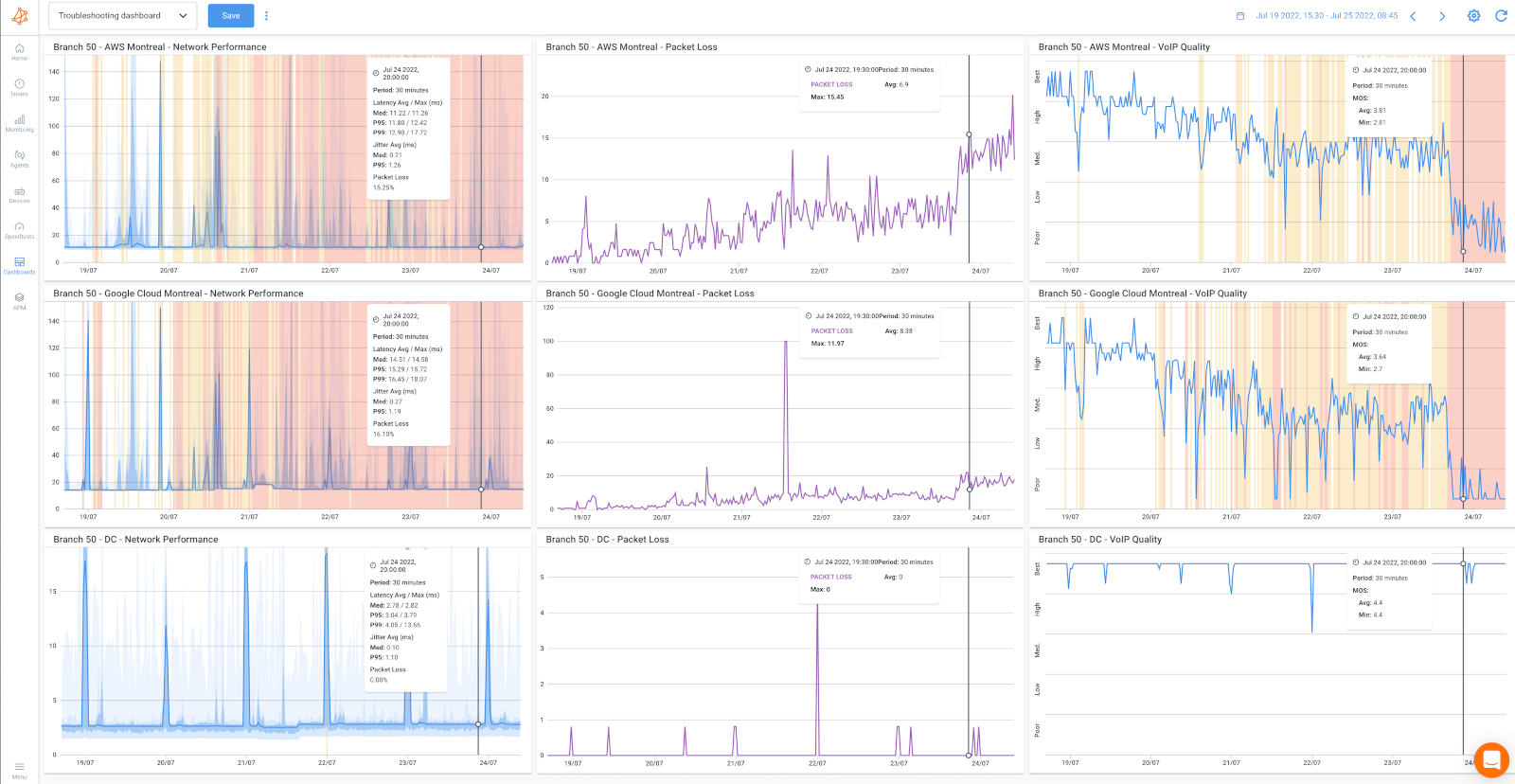
Network Round-Trip Time (RTT) vs. Latency: Comparing Network Siblings
In the world of networking and data transmission, terms like "Network Round-Trip Time (RTT)" and "latency" often take center stage, reflecting the critical aspect of speed and responsiveness in today's digital landscape. While these terms are sometimes used interchangeably, they represent distinct facets of network performance.
In this section, we’ll unravel the differences between Network Round-Trip Time (RTT) and latency. Understanding these concepts is fundamental for network administrators and IT professionals as it enables them to grasp the nuances of network performance and address specific challenges effectively.
I. Defining Latency
Latency is a general term that refers to any delay or lag in data transmission within a network . It encompasses all delays encountered during data communication, including the time it takes for data to travel between two points (which is what RTT specifically measures), as well as other types of delays such as processing delays, queuing delays, and transmission delays.
Latency can be categorized into several types:
- Propagation Delay : The time it takes for a signal or data packet to physically travel over the network medium (e.g., copper cables, fibre-optic cables, or wireless links). It is directly related to the distance between two network points and the speed of the medium.
- Transmission Delay : The time it takes to push the entire data packet into the network medium. It is influenced by the packet's size and the speed of the network link.
- Processing Delay : The time it takes for network devices like routers and switches to process and forward data packets. This can be affected by the performance of these devices and their configurations.
- Queuing Delay : The time data packets spend in queues at various points in the network, waiting for their turn to be processed. High congestion or network traffic can increase queuing delays.
- Jitter : Jitter refers to variations in latency. Inconsistent latency can affect the predictability of network performance, which is particularly critical for real-time applications.
II. Defining Network Round-Trip Time (RTT)
As we've already discussed in this article, RTT is a specific metric used to measure the time it takes for a data packet to travel from its source to its destination and back to the source . It is a subset of latency that focuses on the round-trip journey of a packet. RTT is measured in milliseconds (ms) and is often used to evaluate network responsiveness.
The RTT calculation typically involves the following timestamps:
- The time the sender sends the packet.
- The time the sender receives an acknowledgment (ACK) from the receiver.
- The time the receiver receives the packet.
- The time the receiver sends the ACK back to the sender.
By subtracting the appropriate timestamps, you can calculate the RTT for a specific packet.
In summary, latency is a broader term that encompasses various types of delays in data transmission, including RTT. RTT specifically measures the round-trip time for a packet, which is crucial for understanding the responsiveness of a network, particularly in applications that require timely data exchange, such as video conferencing or online gaming.
We asked a supercomputer “What is latency”, its impact on network performance, and strategies for minimizing it and created this comprehensive guide.
The Quest for Lower Network Round-Trip Time: How to Reduce Network RTT
In the quest for network optimization and superior user experiences, one metric stands as a sentinel of responsiveness - Network Round-Trip Time (RTT). A lower RTT signifies not only the swift transmission of data but also the realization of network efficiency, seamless applications, and satisfied users.
Here, we will explore the art of reducing RTT through a variety of carefully crafted strategies. From optimizing network topology to the art of content caching and compression, from harnessing the power of load balancing to the efficiency of Content Delivery Networks (CDNs), we will venture into the multifaceted realm of RTT reduction.
I. Strategies for Reducing Network RTT
Reducing RTT is a fundamental objective in optimizing network performance . So, there are several strategies to help you achieve this:
- Optimizing Network Topology : A well-designed network topology that minimizes the number of network hops and ensures efficient routing can significantly reduce RTT. Strategies like hierarchical network design and route optimization contribute to lower latency.
- Quality of Service (QoS) Implementation : Prioritizing real-time traffic and critical applications through QoS policies can reduce contention for network resources and lower RTT for those essential services.
- Edge Computing : Deploying computing resources closer to end-users or IoT devices at the network edge can reduce RTT by decreasing the physical distance that data needs to travel.
- TCP/IP Optimization : Fine-tuning TCP/IP parameters and employing technologies like TCP window scaling and selective acknowledgments can improve data transfer efficiency and lower RTT.
II. Load Balancing and Redundancy for Reducing Network RTT
Load balancing and redundancy are vital components in RTT reduction:
- Load Balancing : Distributing network traffic across multiple servers or paths ensures that no single server or network link becomes overwhelmed. This strategy not only increases network capacity but also reduces the likelihood of network congestion and high RTT.
- Redundancy : Implementing redundancy through network failover mechanisms or backup links can mitigate the impact of network failures. Redundancy ensures that if one path experiences issues, traffic can be rerouted quickly, minimizing RTT.
III. Content Delivery Networks (CDNs) for Reducing Network RTT
CDNs are instrumental in RTT reduction, particularly for web content delivery:
- Caching : CDNs cache content on servers located in geographically distributed edge locations. This means users can access content from a nearby server, reducing the need to retrieve data from the origin server, and consequently lowering RTT.
- Content Prioritization : CDNs allow prioritizing and delivering the most critical content quickly, which is especially beneficial for reducing RTT for web pages, images, and videos.
IV. Caching and Compression for Reducing Network RTT
Caching and compression techniques are powerful tools for minimizing RTT:
- Data Caching : Caching frequently accessed data locally, either at the client side or at intermediate network nodes, allows for quicker retrieval of data, reducing RTT.
- Data Compression : Compressing data before transmission and decompressing it at the receiver's end decreases the amount of data to be transferred, ultimately lowering RTT.
By implementing these strategies and technologies, network administrators and IT professionals can actively work to reduce RTT, enhance network performance, and deliver a more responsive user experience. Each strategy offers a unique approach to address latency and can be adapted to the specific needs and goals of the network environment.
Tools and Technologies for Optimizing Network Round-Trip Time: Network RTT Optimization
In the realm of network performance, the pursuit of lower Network Round-Trip Time (RTT) is both an art and a science. It requires the judicious selection and deployment of tools and technologies that act as enablers, elevating networks to realms of enhanced responsiveness and efficiency.
Here, we uncover the spectrum of tools at your disposal, explore their capabilities, and provide insights into the selection process to ensure you choose the right tools that align with your unique business needs. Earlier in this article, we already talked about measuring RTT and identifying RTT issues with Network Performance Monitoring tools - which are also a key tool for optimizing round-trip time.
With the right tools in your arsenal, you can orchestrate a network that not only understands the melody of RTT but dances to its tune, delivering a harmonious and responsive user experience.
I. Network Monitoring and Analytics Solutions for Optimizing Network RTT
Monitoring and analytics tools are instrumental in the quest for RTT optimization:
- Network Performance Monitoring (NPM) : NPM solutions continuously monitor network performance, providing real-time visibility into RTT metrics. They enable network administrators to detect and diagnose issues promptly, making them a vital tool for maintaining low RTT.
- Packet Capture and Analysis Tools : Packet capture tools allow the in-depth analysis of network traffic. Administrators can use these tools to capture and examine packets, enabling them to identify bottlenecks and other issues contributing to RTT delays.
- Network Traffic Analysis : Advanced network traffic analysis solutions provide insights into application behaviour, network usage , and patterns. These tools help optimize network paths and configurations to lower RTT.
II. SD-WAN and Network Optimization Platforms for Optimizing Network RTT
SD-WAN (Software-Defined Wide Area Network) and network optimization platforms offer dynamic solutions for RTT optimization:
- SD-WAN : SD-WAN technology leverages multiple network connections and dynamically routes traffic over the most efficient path. It includes features such as traffic prioritization and application-aware routing, which are beneficial for optimizing RTT for critical applications. The same goes for Dual-WAN networks .
- WAN Optimization Controllers : These devices optimize data traffic between WAN endpoints by employing techniques like data deduplication, compression, and caching. WAN optimization reduces the amount of data transferred, reducing RTT.
- Content Delivery Platforms : Content delivery platforms, combined with CDNs, accelerate the delivery of web content by distributing it to edge servers. This minimizes the physical distance data needs to travel, resulting in reduced RTT for web-based services.
III. Choosing the Right Tools for Optimizing RTT in Your Business
Selecting the right tools for RTT optimization requires careful consideration:
- Assessing Business Needs : Start by identifying the specific requirements of your business. Consider factors like the nature of your applications, your network topology, and your performance goals. This assessment guides the choice of tools and technologies.
- Scalability : Ensure that the selected tools and technologies can scale with your business as it grows. Scalable solutions can adapt to increased network demands without compromising RTT.
- Compatibility : The tools and technologies you choose should seamlessly integrate with your existing network infrastructure. Compatibility ensures smooth implementation and operation.
- Budget Considerations : Evaluate the cost of implementation and ongoing maintenance. Balancing your budget with the need for high-performance tools is vital to achieving cost-effective RTT optimization.
- Monitoring and Maintenance : Plan for continuous monitoring and maintenance of the chosen tools and technologies. Regular updates and adjustments are necessary to adapt to evolving network conditions and maintain low RTT.
By exploring the array of tools and technologies available for RTT optimization and making informed choices that align with your specific network requirements, you can ensure that your network operates at its peak performance, delivering low RTT and a seamless user experience.

Harnessing the Power of Round-Trip Time (Network RTT) Optimization for Business Success
In the fast-paced digital landscape, where every millisecond counts, optimizing Network Round-Trip Time (RTT) should be a top priority for network admins. Achieving low and consistent RTT not only enhances the user experience but also impacts business operations in numerous ways.
For businesses, RTT optimization means improved productivity, reduced downtime, and the ability to leverage real-time applications to their full potential. In e-commerce, it can translate to higher sales, as low latency ensures swift page loads and seamless transactions. For video conferencing and collaboration tools, it means clearer communication and increased efficiency. In the realm of online gaming, it can be the difference between a competitive edge and a frustrating experience for gamers.
By harnessing the power of RTT optimization, businesses ensure that their digital offerings meet the high expectations of today's users and remain competitive in an ever-evolving market.
Measuring and Optimizing Network RTT with Obkio’s NPM Tool
To start measuring and optimizing RTT, you need the right tools, and Obkio's Network Performance Monitoring (NPM) tool stands as a valuable ally.
With Obkio, you can measure, monitor, and optimize RTT with precision. Get real-time insights into network performance, offering visibility into RTT metrics at various network points. Obkio equips network admins and IT professionals with the means to detect and resolve RTT issues promptly, ensuring that network operations remain seamless and efficient. With Obkio, you can proactively manage RTT, detect anomalies, and maintain low-latency network performance.
As you harness the power of Obkio's NPM tool, you're well-equipped to elevate your network to new heights of efficiency, ultimately contributing to the success of your business in a digitally connected world!
- 14-day free trial of all premium features
- Deploy in just 10 minutes
- Monitor performance in all key network locations
- Measure real-time network metrics
- Identify and troubleshoot live network problems
You can rest assured that we're not like those pushy Sellsy people - there's no catch here. We firmly believe in the excellence of our product, but if it's not the right fit for you, we understand and want what's best for you.
These might interest you
19 network metrics: how to measure network performance, how to measure latency, say goodbye to network headaches..
Get a live demo of Obkio now!
Did you know?
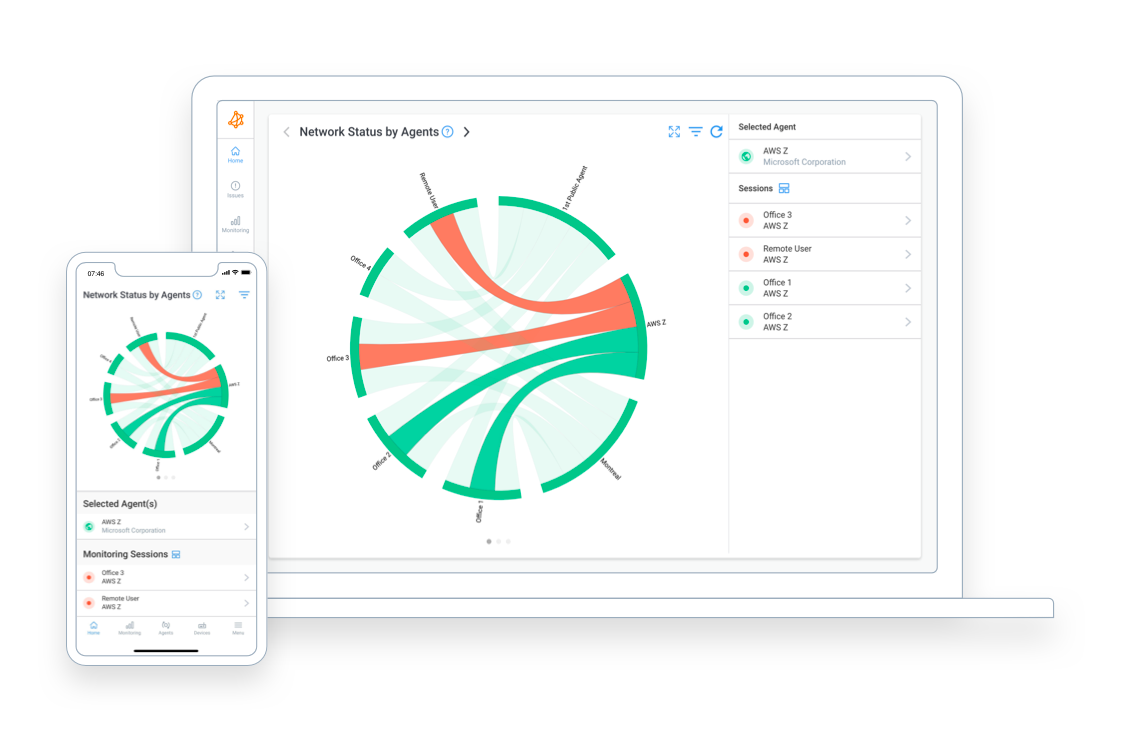
- Looking Glass
- Developer Tools
- Status Page
- Case studies
- Press & Media
- Product Roadmap
- Product Documentation
- API Documentation
- Help Center
- CDN for Gaming
- Game Server Protection
- Game Development
- CDN for Video
- Video Hosting
- Live Streaming
- Video Calls
- Metaverse Streaming
- TV & Online Broadcasters
- Sport Broadcasting
- Online events
- Cloud for financial services
- Image Optimization
- Website Acceleration
- WordPress CDN
- White Label Program
- CDN for E-commerce
- AI Universities
- Online Education
- Wordpress CDN
- DDoS Protection
- Penetration Test
- Web Service
- White Label Products
- Referral Program
- Data Migration
- Disaster Recovery
- Content Hub Content Hub Blog Learning News Case studies Downloads Press & Media API Documentation Product Roadmap Product Documentation Help Center
- Tools Tools Looking Glass Speed Test Developer Tools Status Page
- Talk to an expert
- Under attack?
Select the Gcore Platform
- Edge Delivery (CDN)
- DNS with failover
- Virtual Machines
- Cloud Load Balancers
- Managed Kubernetes
- AI Infrastructure
- Edge Security (DDOS+WAF)
- Object Storage
- ImageStack (Optimize and Resize)
- Edge Compute (Coming soon)
- VPS Hosting
- Dedicated Servers
What is round-trip time (RTT) and how to reduce it?
In this article, factors affecting rtt, how to calculate rtt using ping, normal rtt values, how to reduce rtt, i want to reduce rtt with cdn. what provider to choose.

Round-trip time (RTT) is the time it takes for the server to receive a data packet, process it, and send the client an acknowledgement that the request has been received. It is measured from the time the signal is sent till the response is received.
When a user clicks a button on a website, the request is sent to the server as a data packet. The server needs time (RTT) to process the data, generate a response, and send it back. Each action, like sending a form upon a click, may require multiple requests.
RTT determines the total network latency and helps monitor the state of data channels. A user cannot communicate with the server in less than one RTT, and the browser requires at least three round trip times to initiate a connection:
- to resolve the DNS name;
- to configure the TCP connection;
- to send an HTTP request and receive the first byte.
In some latency-sensitive services, e.g., online games, the RTT is shown on the screen.

Distance and number of intermediate nodes. A node is a single device on the network that sends and receives data. The first node is the user’s computer. A home router or routers at the district, city, or country level are often intermediate nodes. The longer the distance between the client and server, the more intermediate nodes the data must pass through and the higher the RTT.
Server and intermediate node congestion. For example, a request may be sent to a fully loaded server that is concurrently processing other requests. It can’t accept this new request until other ones are processed, which increases the RTT. The RTT includes the total time spent on sending and processing a request at each hop, so if one of the intermediate nodes is overloaded, the RTT adds up.
You never know exactly to what extent the RTT will grow based on how the infrastructure is loaded; it depends on individual data links, intermediate node types, hardware settings, and underlying protocols.
Physical link types and interferences. Physical data channels include copper, fiber optic, and radio channels. The RTT here is affected by the amount of interference. On the Wi-Fi operating frequency, the noise and other signals interfere with the useful signals, which reduces the number of packets per second. So, the RTT is likely to increase over Wi-Fi than over fiber-optics.
To measure the RTT, you can run the ping command in the command line, e.g., “ping site.com.”

Requests will be sent to the server using ICMP. Their default number is four, but it can be adjusted. The system will record the delayed time between sending each request and receiving a response and display it in milliseconds: minimum, maximum, and average.
The ping command shows the total RTT value. If you want to trace the route and measure the RTT at each individual node, you can use the tracert command (or traceroute for Linux or Mac OS). It is also can be performed via the command line.
Many factors affect RTT, making it difficult to establish a normal—the smaller the number, the better.
In online games, over 50 milliseconds are noticeable: players cannot accurately hit their targets due to network latency. Pings above 200 milliseconds matter even when users browse news feeds or place online orders: many pages open slowly and not always fully. A buyer is more likely to leave a slow website without making a purchase and never come back, which is what 79 percent of users do .
Let’s compare the pings of the two sites—the US jewelry store Fancy and the German news portal Nachrichtenleicht.de . We will ping them from Germany.

The RTT of a German news portal is almost three times lower than that of a US store because we ping from Germany. There are fewer nodes between the user and the server, which are both in the same country, so the RTT is lower.
Connect to a content delivery network (CDN). The hosting provider’s servers are usually located in the same region where most of the audience lives. But if the audience of the site grows or changes geographically, and content is requested by users who are far away from the server, RTT increases for them, and the site loading speed is slower. To increase the loading speed, use a CDN.
CDN (Content Delivery Network) is a service that caches (mostly static) content and stores it on servers in different regions. Therefore, only dynamic content is downloaded from the main source server, which is far from the user. Heavy static files—the main share of the website—are downloaded from the nearest CDN server, which reduces the RTT by up to 50 percent.

For example, the client requests content from a CDN-connected site. The resource recognizes that there is a caching server in the user’s region and that it has a cached copy of the requested content. To speed up the loading, the site substitutes links to files so that they are retrieved not from the hosting provider’s servers, but from the caching server instead since it is located closer. If the content is not in the cache, CDN downloads it directly from the hosting server, passes it to the user, and stores it in the cache. Now a client on the same network can request the resource from another device and load the content faster without having refer to the origin server.
Also, CDN is capable of load balancing: it routes requests through redundant servers if the load on the closest one is too high.
Optimize content and server apps. If your website has visitors from different countries/regions, you need a CDN to offset the increased RTT caused by long distances. In addition, the RTT is affected by the request processing time, which can be improved by the below content optimizations:
- Audit website pages for unnecessary scripts and functions, reduce them, if possible.
- Combine and simplify external CSS.
- Combine JavaScript files and use async/await keywords to optimize their processing—the HTML code first, the script later.
- Use JS and CSS for individual page types to reduce load times.
- Use the tag instead of @import url (“style.css”) commands .
- Use advanced compression media technologies: WebP for images, HEVC for video.
- Use CSS-sprites: merge images into one and show its parts on the webpage. Use special services like SpriteMe.
For fast content delivery anywhere in the world, you need a reliable CDN with a large number of points of presence. Try Gcore CDN —this is a next-generation content delivery network with over 140 PoPs on 5 continents, 30 ms average latency worldwide, and many built-in web security features. It will help to accelerate the dynamic and static content of your websites or applications, significantly reduce RTT, and make users satisfied.
Related product
Try gcore cdn.
- 150+ points of presence
- Low latency worldwide
- Dynamic content acceleration
- Smart asset optimization
- Top-notch availability
- Outstanding connectivity
Related articles
- The Development of AI Infrastructure: Transitioning from On-Site to the Cloud and Edge
- What is Managed Kubernetes
- Ways to Harm: Understanding DDoS Attacks from the Attacker’s View
Subscribe and discover the newest updates, news, and features
- Skip to main content
- Skip to search
- Skip to select language
- Sign up for free
Round Trip Time (RTT)
Round Trip Time (RTT) is the length time it takes for a data packet to be sent to a destination plus the time it takes for an acknowledgment of that packet to be received back at the origin. The RTT between a network and server can be determined by using the ping command.
This will output something like:
In the above example, the average round trip time is shown on the final line as 26.8ms.
- Time to First Byte (TTFB)
What Is Wi-Fi RTT?
- Wi-Fi Site Surveys, Analysis, Troubleshooting
- 969 User reviews
Have you ever noticed that your smartphone can pinpoint your location with far greater accuracy when you’re outside than when you’re indoors? That’s because GPS accuracy has been steadily improving over the years, largely thanks to changes in satellite and receiver hardware. Besides, one or two meters here and there doesn’t mean much when walking down the street.
However, one or two meters indoors can be the difference between the living room and the bathroom or the meat aisle and the fresh produce section.
Currently, smartphones are able to achieve indoor accuracy of slightly less than 10 meters, which is insufficient for anything else apart from very course location tracking. Fortunately, there’s already technology available that will improve indoor accuracy to the one-meter level, and its name is Wi-Fi Round-Trip-Time, or Wi-Fi RTT for short.
What Is RTT?
Wi-Fi RTT is a feature added to the IEEE 802.11 protocol by the Task Group mc (TGmc) of the IEEE 802.11 Working Group, sometimes referred to as IEEE 802.11mc . The purpose of Wi-Fi RTT is to allow devices to measure the distance to nearby Wi-Fi routers and determine their indoor location with a precision of 1-2 meters.
If you’ve ever used Google’s “Find My Device” service to see the last known position of your smartphone on a map only to see a marker vaguely placed at our house, you can probably already see where the need for Wi-Fi RTT comes from.
Unsurprisingly, Google has added support for the technology to Android 9 Pie, and it has promised to add support for Wi-Fi RTT to the Google Wi-Fi mesh router. Other companies are likely to follow suit because Wi-Fi RTT could be a game-changer when it comes to home automation.
Just imagine waking up in the morning, walking into the kitchen, and hearing your coffee maker automatically turn on because your smartphone is aware of your exact location and programmed to tell your coffee maker to make you a cup of coffee when you enter your kitchen.
But Wi-Fi RTT isn’t just for individual smartphone users. Companies and organizations will be able to help their visitors get to where they want to go in a way that’s extremely convenient, modern, and potentially highly interactive and even monetizable. A shopping mall, for example, could display nearest discounts along with navigational information.
How Does Wi-Fi RTT Work?
The key to understanding how Wi-Fi RTT works is round-trip time, sometimes referred to as round-trip delay. Here’s one concise RTT definition: network round-trip time is the length of time it takes for a signal to be sent plus the length of time it takes for an acknowledgment of that signal to be received.
Thanks to Wi-Fi RTT, smartphones will soon be able to use time-of-flight instead of signal strength to figure out how far away they are from Wi-Fi routers. With a single Wi-Fi router, you get the distance. With three or more Wi-Fi routers, trilateration (the process of determining absolute or relative locations of points by measurement of distances) with an accuracy of one to two meters becomes possible.
The users of Android P smartphones don’t have to be connected to any Wi-Fi routers for Wi-Fi RTT to work because only the smartphone is used to determine distance. Google has tied Wi-Fi RTT into Android’s existing location system to protect the privacy of its users. What’s more, Wi-Fi RTT transactions require the used MAC address to be randomized as a protection against the location tracking of individual smartphone users by unauthorized third-parties.
Which Devices Support Wi-Fi RTT?
From the technical standpoint, virtually any modern 802.11ac router could support Wi-Fi RTT with a firmware upgrade. The unfortunate reality is that the manufacturers of wireless routers would much rather come up with brand-new products than many firmware upgrades for the existing ones simply because companies don’t make money out of firmware upgrades.
As we’ve already mentioned, Google has promised to add support for Wi-Fi RTT to the Google Wi-Fi mesh router, but the company has yet to act on its promise. So far, the only Wi-Fi RTT network certified products are:
To check Wi-Fi RTT support, you need to look up whether your Wi-Fi router comes with any of these Wi-Fi RTT network certified products. One such router is the Linux-driven Compulab WILD Wi-Fi router , which has the Intel Dual Band Wireless-AC 8260card.
According to Compulab, one WILD router can track other WILD routers with an accuracy of under 0.5 meters, making it useful for applications in retail, health care, transportation, logistics, manufacturing, smart buildings, and entertainment, just to give a few examples.
If you decide to purchase any Wi-Fi RTT-compatible router, it’s important that you use a professional Wi-Fi analysis tool like NetSpot to find the best spot for it and continuously monitor various aspects of your Wi-Fi network to achieve optimal performance.
NetSpot works with all with 802.11a/b/g/n/ac/ax wireless network adapters and supports 2.4 GHz and 5 GHz frequency bands at 20/40/80/160 MHz channels. You can download it for free and run it on a MacBook (macOS 10.10+) or any laptop (Windows 7/8/10/11).
Wi-Fi RTT is about to make indoor location tracking far more accurate than it is today. So far, there are only a few Wi-Fi RTT network certified products out there, but this will likely change very quickly considering that Google has already added support for Wi-Fi RTT in Android 9.

- Cross-platform
- Mac/Windows
- Get NetSpot
- Learn more about NetSpot
Read next in All about Wi-Fi
- Round Trip Time
Round Trip Time, or RTT, also known as “round-trip delay time” is the time it takes for a signal to be sent from a transmitter to a receiver plus the time it takes to verify that the signal has been received; therefore, Round Trip Time is the time it takes for a signal to be sent from one location to another and back again. RTT almost always relates to telecommunication, but may refer to the Internet, satellite communications, or radar systems.
How Round Trip Time Works
Round Trip Time is dependent on a number of factors, including the data transfer rate of the source, the nature of the transmission medium, the distance between the source and the destination, the number of nodes between the source and the destination, the amount of traffic or bandwidth on the network that is being used, the number of other requests being handled by the receiver or nodes along the transmission path, the processing capabilities of the source, receiver, and nodes, and the presence of interference.
Applications
Round Trip Time can refer to a wide variety of transmissions, such as copper-cable Internet transmissions, wireless Internet transmissions, satellite transmissions, and cell phone transmissions. In Internet transmissions, the RTT may refer to “ping time”, which is the amount of time data can be sent to a remote location and sent back, and may be identified by using the ping command. In satellite transmissions, the RTT can be calculated by using the Jacobson/Karels algorithm.
Calculating a transmission’s RTT is advantageous because it allows users and operators to identify how long a transmission will take to complete and how fast a network can operate. RTT in both Internet and satellite transmissions is particularly important because it allows network providers to establish data speeds and allocate bandwidth to subscribers accordingly.

Rate this article:
- Mail this article
- Print this article
Related Posts

C Band is the original frequency allocation for communications satellites. C-Band uses 3.7-4.2GHz for downlink ...
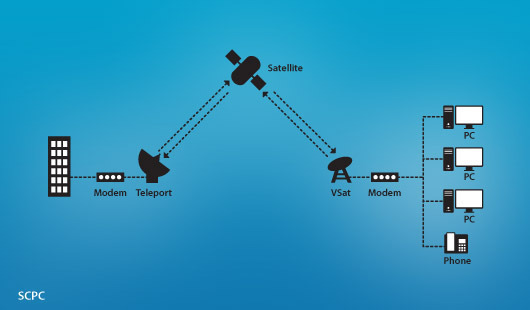
- SCPC (Single Channel Per Carrier)
SCPC stands for Single Channel Per Carrier. SCPC is a form of satellite transmission where ...

8PSK (8 Phase Shift Keying) is a phase modulation algorithm. Phase modulation is a version ...
Got Something To Say: Cancel reply
Your email address will not be published. Required fields are marked *
Let us know what you have to say:
Save my name, email, and website in this browser for the next time I comment.
- Mobile Satellite Service
- What is Intersymbol Interference?
- Symbol Rate
- QPSK (Quadrature Phase Shift Keying)
- Reed-Solomon
- Retrograde Orbit
- MCPC (Multiple Channel Per Carrier)
- Transponder
- Weather Satellite
- Satellite Dishes
- Low Earth Orbit
- Satellite Systems
- Backward Error Correction (BEC)
- What is a BUC?
- Geostationary Satellite
- Fixed Satellite Service
- IFL (Interfacility Link)
- TV-GPS Technology
- How GPS Tracking Works
- FSK (Frequency Shift Keying)
- IDU (In-Door Unit)
- ODU (Out-Door Unit)
- GPS (Global Positioning System)
- How Satellite Images Are Made
- VSAT (Very Small Aperture Terminal)
- LNB (Low Noise Block)
- Medium Earth Orbit
- Forward Error Correction (FEC)
- Where to See Free Satellite Images
Program to Calculate the Round Trip Time (RTT)
Round-trip time(RTT) in networking, also called the round-trip delay time is a benchmark that measures the amount of time it takes for a data packet to be sent in addition to the amount of time it takes for acceptance of that signal to be received in milliseconds. RTT delay also includes propagation times between two communication endpoints.
What is Round-Trip Time?
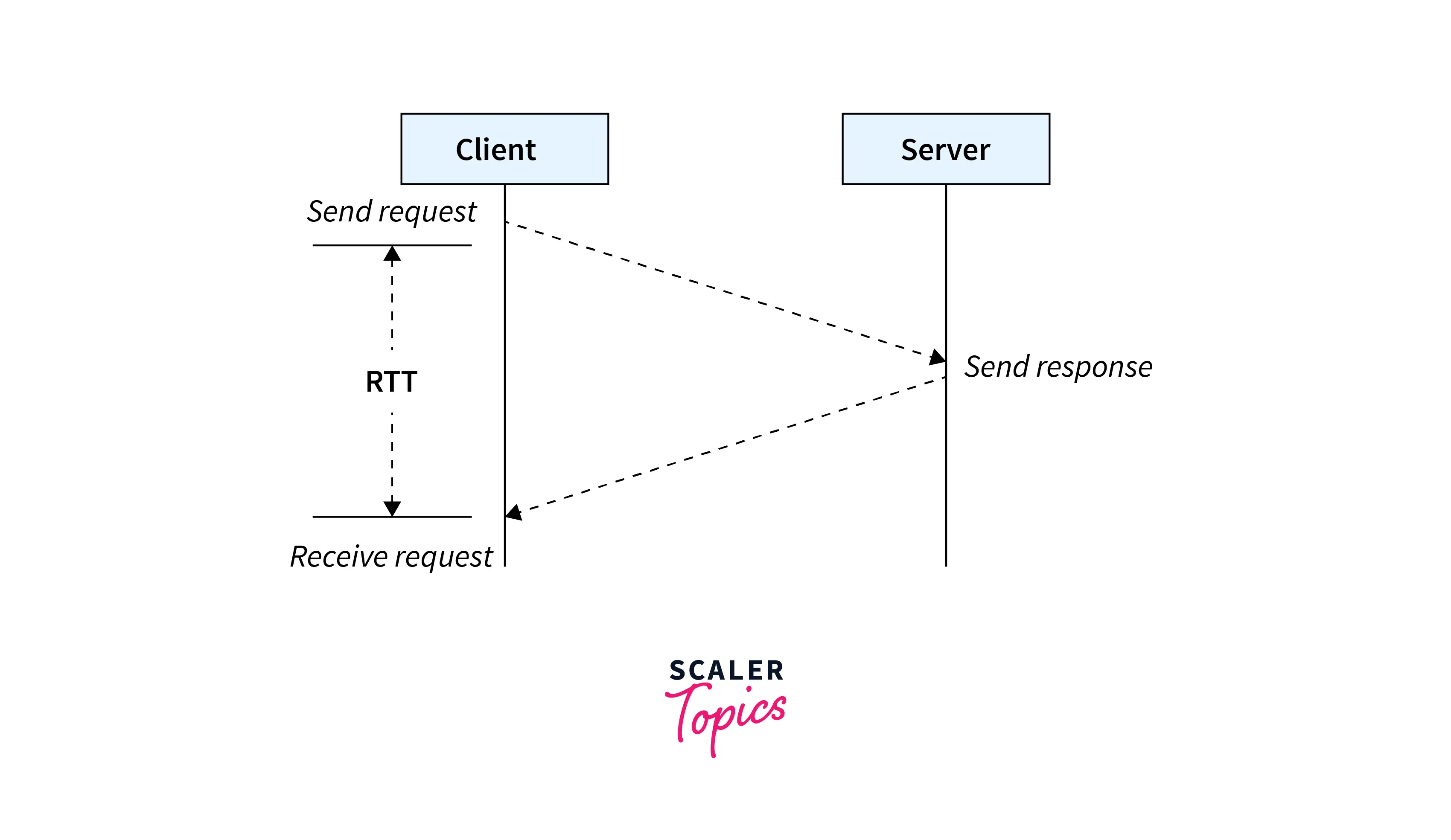
RTT can be defined by an end-user with the help of Internet protocol by pinging that address .
What is a Good Round-Trip Time?
Situations can be different for every other application. So it's not possible to predict an exact time.
A fully managed and determined desktop virtualization service such as AWS WorkSpaces allows its users to access the resource and applications they need. It has basically three thresholds for RTT.
- The round-trip time from the client's network to the AWS Region that the WorkSpaces are in should be lower than 100ms .
- If the round-trip time is between 100ms and 200ms , the user can access WorkSpace, but performance is pompous .
- If the round-trip time is between 200ms and 375ms , the performance is cheapened .
- If the round-trip time exceeds 375ms , the WorkSpaces client connection is discarded .
So in general the users should have a round-trip time of 100 milliseconds for normal usage of the application and a maximum of 200 milliseconds before the application starts to degrade.
Implementation in Python
Here's a Python code implementation to calculate the RTT
How to Reduce RTT
There are two ways through which Round-Trip Time can be reduced.
1. Reducing RTT with Amazon CDN Distribution
CDNs or Content Delivery Networks were created to solve to reduce round-trip time . Using CDN as a service it is reasonable to expect a decrease in RTT by up to half or more.
CDN can affect RTT in the following ways:
- Scalability: CDN as a cloud service, provides high scalability and the ability to exercise a vast number of user requests.
- Load Distribution: When the traffic is high, CDNs use backup edge servers with lower congestion for route requests, this speed's up the server's response time and lowers RTT.
- Points of Presence (PoPs): Content Delivery Network also manages a geographical network of dispersed PoPs data centers , each of them containing cached copies of site content data, which are in charge of communicating with site visitors in their region. This helps in reducing the distance a signal has to travel and the number of network stops required to reach a server.
- Web Caching: CDN has the power to cache media, HTML, and dynamic content on a PoP in close proximity to the user. One advantage of this is sometimes the request is fulfilled using a local PoP without traveling to the origin server , which helps in lowering RTT .
2. General Ways to Reduce RTT
- Browser Caching: Modern Browser can cache certain resources of a website locally in the system to reduce RTT .
- Discarding Broken links: Requests which result in 404/410 errors , can be discarded to avoid wasteful reports .
- Bringing content closer to the user: Servers close to the user should be used, this lower's the RTT by several amounts.
- Merging external scripts: If external scripts can be merged into as few files, this helps to lower RTT several times.
- Lessen HTTP/s directs: Minimizing HTTP/s directs from one URL to another lowers RTT and wait time.
- RTT is a crucial tool for determining the strength of the network. It is the time between the request of the data and the display of the data.
- Factors such as Distance, Network Hops, and Traffic levels can bring a massive change to the value of RTT.
- In Satellite transmissions, RTT can be measured using Jacobson/Karels algorithm.
- Calculation of RTT is advantageous because it helps the user and operators how long will it take the signal to complete the transmission .
- RTT also helps in determining the reliability of the network as the speed of a network.
Two-way time transfer involves signals that travel both ways between the two clocks or oscillators that are being compared, as shown in the figure below. A half-duplex channel is a one-way system that is turned around to retransmit a signal in the opposite direction. In this method, the one-way delay between the transmitter and receiver is estimated as one-half of the measured round trip delay. The delay estimate can be sent to the user and applied as a correction, or the transmitter can advance the signal so that it arrives at the user's site on time. The latter is how the NIST Automated Computer Time Service (ACTS) system works. Internet time transfers using the Network Time Protocol (NTP) also use a half-duplex technique. A full-duplex system uses one-way signals transmitted simultaneously in both directions. In this case data must be exchanged in both directions so that the two data sets can be differenced.
Both two-way methods have advantages and limitations. The half-duplex system has the advantage of only requiring "reflecting" hardware at one station, but it is susceptible to fluctuations in the delay, especially when the period of the fluctuations is comparable to the round trip delay. A full-duplex system does not have this problem since timing information is transmitted in both directions simultaneously. However, it requires complete transmit and receive hardware at both stations.
A full duplex two-way system does not depend on the actual length of the path, provided that the inbound and outbound delays are equal. This requirement may be difficult to realize completely since these systems usually require separate station hardware for the two directions (with delays that may not be the same). The transmission medium can also cause asymmetries if it is dispersive and if the signals in the two directions use different frequencies.
A full duplex two-way technique using a geostationary communications satellite as a relay station is illustrated below. This technique is called Two-Way Satellite Time and Frequency Transfer (TWSTFT). The TWSTFT technique provides stable and accurate time transfer since nearly all of the propagation delay cancels out due to symmetry. Recently the Bureau International des Poids et Mesures (BIPM) has started using two-way via a commercial Ku-band communication satellite as the primary time transfer technique for some European and transatlantic links, since it performs significantly better than GPS common-view . A significant disadvantage of TWSTFT is the added complexity of having to have both transmit and receive hardware at each station. It is also more expensive, since it requires paying for satellite time if a commercial communications satellite is used.
In the TWSTFT technique the basic time interval measurements are made with Time Interval Counters (TICs) at each site. The TICs are started by a pulse from the local clock and stopped by the received pulse from the remote clock. At the same time as the local clock pulse is starting the TIC it is also being transmitted to the other station. The same process goes on at both stations. Typically a one pulse per second (PPS) signal is used. This time interval data is recorded at both sites and then the data files are exchanged and differenced. Generally there is sufficient bandwidth in the communications link that the data can be transferred at the same time that the timing pulses are being transmitted. Thus the two-way technique can be used in essentially real time. The time interval information that is recorded at each station contains the clock differences as well as various delays as shown in the equations below.
TIC(A) = A - B + d TB + d BS + d SBA + d SA + d RA + S B (1)
TIC(B) = B - A + d TA + d AS + d SAB + d SB + d RB + S A (2)
The time difference between clocks A and B can be determined from equations 1 and 2 by differencing the individual simultaneous TIC readings with the result shown below.
As can be seen most of the path delays tend to cancel. However, there is no reason for the transmit and receive delays of the earth station equipment to cancel perfectly since they are caused by physically different pieces of equipment. This area is one of the major sources of instability and inaccuracy in the two-way technique. The satellite delays, d SAB and d SBA , may perfectly cancel since in some cases the same satellite transponder is used for both directions. In other cases different transponders are used and then the cancellation is not perfect. The up and down link paths are physically the same, but the propagation delay is not exactly the same if the up and down link frequencies are different. This is generally the case.
For Ku-band the up link is normally at 14 GHz and the down-link is at 11 GHz. Therefore the effect of the ionosphere is not the same. However, the tropospheric delay will cancel to a large extent since it does not depend strongly on frequency. Another advantage of this two-way technique is that the signal to noise ratio is favorable. Antenna reflectors of one or more meters diameter are normally used at the ground stations, as shown in the photograph. These highly directional antennas also reduce multipath.

The stability of TWSTFT over a 24 hour period is better than 1 ns and has been observed to be as low as 100 picoseconds in some systems. TWSTFT systems can be calibrated to the 1 ns level, but this requires a portable earth station.
For questions or more information contact Victor Zhang at [email protected] .

Encyclopedia … combined with a great Buyer's Guide !
The Photonics Spotlight > 2016-07-05
The Round-trip Phase Shift in an Optical Resonator
Posted on 2016-07-05 as part of the Photonics Spotlight (available as e-mail newsletter!)
Permanent link: https://www.rp-photonics.com/spotlight_2016_07_05.html
Author: Dr. Rüdiger Paschotta , RP Photonics AG , RP Photonics AG
Abstract: The physics of phase shifts in resonators is relevant in many situations, for example in laser physics and ultra-precise laser measurements. This article discusses a number of interesting aspects in that context and can thus help to improve the understanding of the physics of laser beams and resonators.

In many situations, one needs to consider or calculate the round-trip phase shift in an optical resonator , i.e., the total optical phase shift experienced in a complete resonator round trip. Here, one can encounter various interesting aspects, which I discuss in the following. You may have some fun thinking about these things and at the same time improve your understanding of light beams and optical resonators.
Is It a Well Defined Quantity?
Very often, one considers the round-trip phase shift along the resonator axis. In reality, however, we do not have a ray circulating in the resonator, but a light beam (e.g., a laser beam ) with a finite transverse extension. One may now ask whether the on-axis phase shift is really meaningful; after all, part of the light travels somewhat away from the axis, and one might expect that it experiences a different phase shift there; for example, a lens in the resonator would cause a maximum phase shift on the axis and lower phase shifts away from it. Also, the circulating light has some finite divergence , i.e., it covers some range of propagation angles, and one could imagine that these should have an impact on the round-trip phase shift.
It is instructive now to consider resonator modes . By definition, these are field configurations which fully reproduce themselves after a complete resonator round trip. For such a mode, the round-trip phase shift is necessarily an integer multiple of – just because by definition we have a self-reproducing field configuration. This holds for fundamental (axial) modes as well as for higher-order modes. Here, it is perfectly clear that the on-axis round-trip phase shift is representative for the phase shift experienced along any ray which is, for example, transversely shifted away from the resonator axis. This is true despite possible transverse variations of phase shifts e.g. at lenses or curved mirrors : after each complete round trip, the wavefronts must stay unchanged – otherwise, we would not be dealing with a resonator mode.
Now, different modes of a resonator can have different round-trip phase shifts – differing by integer multiples of . You may now wonder what is the round-trip phase shift of some optical field which is a superposition of different modes, having different round-trip phase shifts: is it perhaps some kind of weighted average, no longer restricted to integer multiples of ? No, it isn't: in general, the round-trip phase shift of such a superposition is not a defined quantity. After all, how should one define the phase shift of a beam with arbitrarily crumbled wavefronts? Note also that in general we are not dealing with a monochromatic field anymore: different modes generally have different mode frequencies. So the round-phase shift is not a well defined quantity for arbitrary beams, but it is defined for resonator modes.
One may actually try to excite a resonator mode with a mode-matched monochromatic beam coming from outside, hitting a partially transparent mirror of the resonator. In that case, the optical frequency is controlled from outside and is no longer restricted to discrete mode frequencies. But how about the round-trip phase shift in such a case? It turns out that it is still an integer multiple of ; the external field causes a phase change where it enters the resonator. In that way, you can have discrete values of the round-trip phase shift despite possible continuous variations of the optical frequency.
The Round-trip Group Delay
In many situations, the round-trip time of an optical resonator is relevant; for example, the inverse of that is the pulse repetition rate from a mode-locked laser in case that a single pulse is circulating in its resonator. Many would think that you can calculate this simply as the round-trip distance divided by the velocity of light – possibly taking into account its reduction in optical components, based on their refractive index . This is not exactly true, however. A useful and meaningful definition of round-trip time is the round-trip group delay ; it tells you how much time a short (but not too short) optical pulse requires for one round trip – looking at the pulse maximum. Generally, the group delay is the derivative of the round-trip phase shift with respect to the angular frequency . In the case of resonator modes, you cannot really calculate that derivative since we have only modes with discrete optical frequencies and phase shifts. You may, however, look at a pair of neighbored resonator modes, differing by in their round-trip phase shift and by in terms of optical frequency . From that, you can get the round-trip group delay as – it is just the inverse mode spacing in terms of optical frequency. Interestingly, the mode spacing is influenced not only by the geometrical length, but also by chromatic dispersion and in principle even by wavelength-dependent diffraction effects. (See the encyclopedia article on waveguide dispersion for more details in that direction.)
Taking different pairs of neighbored modes, you will generally obtain slightly different values of the round-trip group delay: it is not just a constant value for a given resonator. Here, you can see how chromatic dispersion can make it difficult to keep the circulating pulse together over many resonator round trips; one therefore often uses some kind of dispersion compensation for mitigating such effects. It must be said, however, that zero chromatic dispersion is not always the best to have, since we also often have some substantial nonlinear effects in mode-locked lasers, which can nicely be combined with some amount of chromatic dispersion. By the way, that also implies that resonator modes, not taking into account any nonlinear effects, are not telling you everything about light propagation in lasers.
Detecting Small Changes of Round-trip Phase Shifts
Imagine that you have some small temperature change affecting the refractive index of some crystal or glass piece within a resonator; alternatively, you could have some change of the round-trip length caused by thermal drifts of mechanical parts or by whatever else. If monochromatic light with a fixed optical frequency were circulating in the resonator, one would then obtain a somewhat changed round-trip phase shift. If the resonator is a laser resonator , the situation is different: the laser will continue to operate on a resonator mode (if not on multiple resonator modes simultaneously), and the resonator mode frequency (or frequencies) will automatically adapt such that the round-trip phase shift stays constant (for each mode).
That can actually be quite convenient for measuring such influences: one can easily detect tiny changes of optical frequencies and therefore tiny influences on the optical field circulating in a laser resonator. As an example, consider a small 1064-nm laser with a 10-GHz mode spacing of its linear resonator. If an end mirror of that resonator is displaced by only 1 nm in the beam direction, this will change the mode frequencies by 10 GHz · (2 · 1 nm / 1064 nm) = 18.8 MHz. If the laser's emission linewidth is not too large, one should be able to detect such a change of optical frequency. Note that single-frequency solid-state lasers often have a linewidth only of a few kHz.
Another thought: if you can get a laser to operate on two modes having different polarization directions, and you can detect a beat note of the corresponding optical frequencies, that beat frequency will extremely sensitively react to the slightest birefringence introduced into your intracavity laser beam.
Some Other Articles
You might also be interested in some older articles on " The Role of Diffraction in Optical Resonators ", " The Resonator Mystery " and " Are Compact Resonators More Stable? ".
This article is a posting of the Photonics Spotlight , authored by Dr. Rüdiger Paschotta . You may link to this page and cite it, because its location is permanent. See also the RP Photonics Encyclopedia .
Note that you can also receive the articles in the form of a newsletter or with an RSS feed .
Questions and Comments from Users
Here you can submit questions and comments . As far as they get accepted by the author, they will appear above this paragraph together with the author’s answer. The author will decide on acceptance based on certain criteria . Essentially, the issue must be of sufficiently broad interest.
Please do not enter personal data here; we would otherwise delete it soon. (See also our privacy declaration .) If you wish to receive personal feedback or consultancy from the author, please contact him, e.g. via e-mail .
Your question or comment:
Spam check:
(Please enter the sum of thirteen and three in the form of digits!)
By submitting the information, you give your consent to the potential publication of your inputs on our website according to our rules . (If you later retract your consent, we will delete those inputs.) As your inputs are first reviewed by the author, they may be published with some delay.
- Python Basics
- Interview Questions
- Python Quiz
- Popular Packages
- Python Projects
- Practice Python
- AI With Python
- Learn Python3
- Python Automation
- Python Web Dev
- DSA with Python
- Python OOPs
- Dictionaries
Program to calculate the Round Trip Time (RTT)
- How to Calculate Expected Round Trip Time?
- Python | How to time the program
- Difference between Round trip time (RTT) and Time to live (TTL)
- Python Program to Create a Lap Timer
- How to add hours to the current time in Python?
- Python - Measure time taken by program to execute
- What is RTT(Round Trip Time)?
- Python | Distance-time GUI calculator using Tkinter
- Calculate Time Difference in Python
- R Program to Calculate Simple Interest
- How to Calculate the Time Between 2 Dates in TypeScript ?
- Program to find the time remaining for the day to complete
- Calculate the IST : Indian Standard Time
- How to Calculate Time in Excel?
- Java Program to Calculate Simple Interest
- Time taken by two persons to meet on a circular track
- How to Round Time to the Nearest Quarter Hour using JavaScript ?
- Java Program to Calculate Difference Between Two Time Periods
- How to get the current date and time in seconds ?
- What is OSI Model? - Layers of OSI Model
- TCP/IP Model
- Basics of Computer Networking
- Types of Network Topology
- Network Devices (Hub, Repeater, Bridge, Switch, Router, Gateways and Brouter)
- RSA Algorithm in Cryptography
- Caesar Cipher in Cryptography
- Differences between TCP and UDP
- TCP Server-Client implementation in C
- Types of Transmission Media
Round trip time(RTT) is the length of time it takes for a signal to be sent plus the length of time it takes for an acknowledgment of that signal to be received. This time, therefore, consists of the propagation times between the two-point of the signal.
On the Internet, an end-user can determine the RTT to and from an IP(Internet Protocol) address by pinging that address. The result depends on various factors:-
- The data rate transfer of the source’s internet connection.
- The nature of transmission medium.
- The physical distance between source and destination.
- The number of nodes between source and destination.
- The amount of traffic on the LAN(Local Area Network) to which end-user is connected.
- The number of other requests being handled by intermediate nodes and the remote server.
- The speed with which the intermediate node and the remote server function.
- The presence of Interference in the circuit.
Examples:
Output:
Please Login to comment...
Similar reads.
- Computer Networks

Improve your Coding Skills with Practice
What kind of Experience do you want to share?
Geostationary satellite latency and time delay ms
Most communications satellites are located in the Geostationary Orbit (GSO) at an altitude of approximately 35,786 km above the equator. At this height the satellites go around the earth in an eastery direction at the same angular speed at the earth's rotation, so they appear to be almost fixed in the sky to an observer on the ground. The earth surface also moves in an easterly direction, so that the sun rises in the east.
The time for one satellite orbit and the time for the earth to rotate is 1 sidereal day or 23 h 56 m 4 seconds.
Radio waves go at the speed of light which is 300,000 km per second.
If you are located on the equator and are communicating with a satellite directly overhead then the total distance, single hop (up and down) is nearly 72,000 km so the time delay is 240 ms . mS means millisecond or 1 thousandth of a second so 240 mS is just under a quarter of a second.
A geostationary satellite is visible from a little less than one third of the earth's surface and if you are located at the edge of this area the satellite appears to be just above the horizon. The distance to the satellite is greater and for earth stations at the extreme edge of the coverage area, the distance to the satellite is approx 41756 km. If you were to communicate with another similarly located site, the total distance is nearly 84,000 km so the end to end delay is almost 280 mS , which is a little over quarter of a second.
Extra delays occur due to the length of cable extensions at either end, and very much so if a signals is routed by more than one satellite hop.
Significant delay can also be added in routers, switches and signal processing points along the route.
Satellites in lower orbits
In recent years there has been increasing interest in low earth orbit (LEO) and medium earth orbit (MEO) satellite networks. These satellites move across the sky and need tracking (or low gain omni-directional) antennas on the ground. Coverage visibility of the earth is less than for geostationary satellites and to provide continuous coverage multiple satellites are used for each network, configured in constellations with complex interlocking orbits designed to give users visibility of one or two satellites at all times. As many as 1000 satellites may be proposed in a such constellation.
O3b MEO network
O3b is an operating constellation of 12 satellites, spaced along in a single medium height orbit directly above the equator . The height is 8062km and this results in lower latency compared with geostationary. This is a key selling point. If a typical single hop path involves sloping path lengths of 11000km the single hop distance is 22000km with a latency of 73 mS. O3b claim a round trip latency of better then 150mS. 150 mS round trip refers to a double hop distance of 11250 + 11250 + 11250 + 11250 km.
Proposed OneWeb network
This is a proposed LEO satellite constellation with some 648 satellites at a height of 1200km. Typical single hop latency, corresponding to 1500km + 1500km would be 10 mS. If the terrestrial end points are not within the coverage of a single satellite (approx 1000km x 1000km) then the distance will be greater, with inter-satellite links via other satellites. I have started a new discussion forum about OneWeb . Please sign up and contribute if you can.
TCP/IP Acceleration:
The use of the TCP/IP protocol over satellite may be improved and a number of companies have developed ways of changing the protocol over the satellite link to achieve IP acceleration.

IMAGES
VIDEO
COMMENTS
In networking, round-trip time ( RTT ), also known as round-trip delay time ( RTD) is defined as a metric that measures in milliseconds the amount of time it takes for a data packet to be sent plus the amount of time it takes for acknowledgement of that signal to be received. This time delay includes propagation times for the paths between the ...
In telecommunications, round-trip delay (RTD) or round-trip time (RTT) is the amount of time it takes for a signal to be sent plus the amount of time it takes for acknowledgement of that signal having been received. This time delay includes propagation times for the paths between the two communication endpoints. In the context of computer networks, the signal is typically a data packet.
Round-Trip Time (RTT) is a fundamental metric in the context of network performance, measuring the time it takes for data packets to complete a round trip from source to destination and back. ... Fiber optic cables generally offer low RTT due to the speed of light in the medium and low signal loss. In contrast, wireless mediums can introduce ...
Factors Influencing RTT. Actual round trip time can be influenced by: Distance - The length a signal has to travel correlates with the time taken for a request to reach a server and a response to reach a browser.; Transmission medium - The medium used to route a signal (e.g., copper wire, fiber optic cables) can impact how quickly a request is received by a server and routed back to a user.
3. Round Trip Time. The RTT is the time between sending a message from a source to a destination (start) and receiving the acknowledgment from the destination at the source point (end). We can also see RTT referred to as Round Trip Delay (RTD). Sometimes, the acknowledgment is sent from the destination to the source almost immediately after the ...
Network hops: It is the time that servers take to process a signal, on increasing the number of hops, RTT will also increase. Traffic levels: ... Round Trip Time refers to a wide variety of transmissions such as wireless Internet transmissions and satellite transmissions. In Internet transmissions, RTT may be identified by using the ping command.
What is round-trip time? Round-trip time (RTT) is the duration in milliseconds (ms) it takes for a network request to go from a starting point to a destination and back again to the starting point. RTT is an important metric in determining the health of a connection on a local network or the larger Internet, and is commonly utilized by network ...
Round-trip time (RTT) is a networking metric that measures in milliseconds the time it takes for a data packet to be sent and the time it takes for an acknowledgment of that signal to be received. The propagation times for the paths between the two communication endpoints are included in this time delay. As you can imagine, a CDN's primary ...
Round-trip time (RTT) in networking is the time it takes to get a response after you initiate a network request. When you interact with an application, like when you click a button, the application sends a request to a remote data server. Then it receives a data response and displays the information to you. RTT is the total time it takes for ...
Round-Trip Time (RTT) In the intricate domain of computer networking, Round-Trip Time, popularly known as RTT, plays an instrumental role. RTT signifies the time it takes for a data packet to travel from a source to a destination and back again. It serves as a key performance metric in networking, helping diagnose network speed and efficiency.
Round-Trip Time (RTT) is a crucial metric in network performance, representing the total time it takes for a signal to travel from a sender to a recipient and back again. Typically measured in milliseconds, RTT is an essential factor in determining the efficiency and responsiveness of network communications, particularly in web applications.
It provides a straightforward way to calculate the Round-Trip Time between two endpoints in a network. The formula for RTT is as follows: RTT = (t2 - t1) + (t4 - t3) t1: The time at which the sender sends the packet. t2: The time at which the sender receives an acknowledgment (ACK) from the receiver.
The round trip time is how long it takes for a request sent from a source to a destination, and for the response to get back to the original source. Basically, the latency in each direction, plus the processing time. ... One of the most obvious sources of network latency is distance: the signals that carry your data travel at more or less the ...
Round-trip time (RTT) is the time it takes for the server to receive a data packet, process it, and send the client an acknowledgement that the request has been received. It is measured from the time the signal is sent till the response is received. When a user clicks a button on a website, the request is sent to the server as a data packet.
Round Trip Time (RTT) is the length time it takes for a data packet to be sent to a destination plus the time it takes for an acknowledgment of that packet to be received back at the origin. The RTT between a network and server can be determined by using the ping command. This will output something like: In the above example, the average round ...
Here's one concise RTT definition: network round-trip time is the length of time it takes for a signal to be sent plus the length of time it takes for an acknowledgment of that signal to be received. Thanks to Wi-Fi RTT, smartphones will soon be able to use time-of-flight instead of signal strength to figure out how far away they are from Wi ...
Round Trip Time, or RTT, also known as "round-trip delay time" is the time it takes for a signal to be sent from a transmitter to a receiver plus the time it takes to verify that the signal has been received; therefore, Round Trip Time is the time it takes for a signal to be sent from one location to another and back again. RTT almost ...
Overview. Round-trip time(RTT) in networking, also called the round-trip delay time is a benchmark that measures the amount of time it takes for a data packet to be sent in addition to the amount of time it takes for acceptance of that signal to be received in milliseconds. RTT delay also includes propagation times between two communication endpoints. ...
Two-way time transfer involves signals that travel both ways between the two clocks or oscillators that are being compared, as shown in the figure below. A half-duplex channel is a one-way system that is turned around to retransmit a signal in the opposite direction. In this method, the one-way delay between the transmitter and receiver is ...
Round-trip time is a complex metric that has several components. It includes propagation delay, processing delay, queuing delay, and encoding delay. Propagation delay is usually the dominant component in RTT. It ranges from a few milliseconds to hundreds of milliseconds depending on whether the endpoints are separated by a few kilometers or by ...
A useful and meaningful definition of round-trip time is the round-trip group delay; it tells you how much time a short (but not too short) optical pulse requires for one round trip - looking at the pulse maximum. Generally, the group delay is the derivative of the round-trip phase shift with respect to the angular frequency $\omega = 2\pi ...
monitors the Round-Trip Time of TCP traffic, by matching data packets with their associated acknowledgments and calculating a time difference. Compared with traditional measurement systems based on active probing or measuring only SYN/ACK packets, our algorithm passively produces many samples for long-running con-nections.
Round trip time(RTT) is the length of time it takes for a signal to be sent plus the length of time it takes for an acknowledgment of that signal to be received. This time, therefore, consists of the propagation times between the two-point of the signal. On the Internet, an end-user can determine the RTT to and from an IP(Internet Protocol) address by pinging that address.
Different approaches have been proposed to measure the signal propagation time, mainly Time of Arrival (ToA) and Round Trip Time (RTT). In fact, recently, the IEEE 802.11-2016 standard has introduced the Fine Time Measurement (FTM) protocol which supports the round trip time measurement and its Android API support has followed [31], [32]. With ...
Geostationary satellite latency and time delay due to distance and the speed of light Home page. Satellite Link Budget. Antenna gain. SETI communications range ... and very much so if a signals is routed by more than one satellite hop. ... O3b claim a round trip latency of better then 150mS. 150 mS round trip refers to a double hop distance of ...
The emerging WiFi Round Trip Time measured by the IEEE 802.11mc standard promised sub-meter-level accuracy for WiFi-based indoor positioning systems, under the assumption of an ideal line-of-sight path to the user. However, most workplaces with furniture and complex interiors cause the wireless signals to reflect, attenuate, and diffract in different directions. Therefore, detecting the non ...